#(for the record that's in the context of a horror game! it was a character analysis)
Explore tagged Tumblr posts
Text
tuesday again 12/24/2024
pair of portentous tuesdayposts: this one is christmas eve and the next one is new year's eve
trying something new with the reading section, where i list off a bunch of books i bounced off and briefly explain why. let me know if this is interesting, or if it's more interesting when i finish a book i sort of enjoyed and really dissect what didn't work for me like with that annoying evil wizard book a couple weeks ago.
listening
the true champ of the past few weeks has been friends at the table's (an actual play podcast about critical worldbuilding, smart characterization, and fun interaction between good friends) horror/weird west season Sangfielle, and i know i have listened to about sixty hours of it bc i have played about sixty hours of stardew valley. i am currently on ep 49, one before the last finale episode, and it feels like it is wrapping up in a very rushed and weird way? maybe i will feel differently after listening to the six coda episodes wrapping up everyones' characters?
the song of the week is fleet foxes’ white winter hymnal, which is morbidly festive without being strictly christmas-y and is not salting the open emotional wound within my chest that is The Holiday Season. album released 2008. christ im old
-
reading
the concept of this gag award is EXTREMELY funny to me. i wish the EFF sent them a little physical trophy. perhaps a challenge coin.
bounced off a lot of stuff. the six larger books and the far top right are all from my absolute favorite thrift store with the worst vibes, who regularly has a 8/$1 media sale bc they actually want to be more of a kitchen goods and home decor thrift store and don't really want to constantly be overflowing with records no one buys. yet here they are.
i really do need to find a good indie used bookstore around here that will take books and give me back slightly more in store credit than in cash. bc i would like to fill some missing chunks of trilogies/fill out the star wars shelves a little more. but every time i have gone to half price books i have had an unpleasant time.
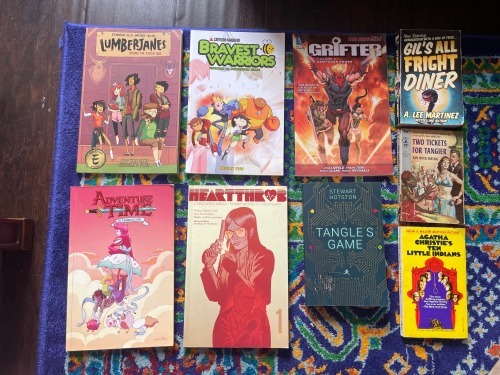
lumberjanes/bravest warrior/adventure time were not making me feel nostalgic and in fact made me quite sad instead (more in a memento mori way than in subject matter) so they're going to a friend's kid
glad i looked up Heartthrob (despite the really good premise of woman haunted by her heart donor) on my library's comic app bc the third one seems to mostly take place in a mental hospital which is really never a vibe i want
GRIFTER has art i don't love and a bland storyline about an ex-marine who is the saddest boy in the world and can also detect literal space aliens living among us. no thank you
tangle's game has a close-call near-sexual assault in the first chapter. no thank you! cool dystopic social credit score premise but no thanks!
gil's all fright diner is about the king of vampires and the duke of werewolves but they're hicks. the narrator hates that they're dumb hicks. did not jive with the authorial voice on this one
i bought Two Tickets to Tangiers in high school bc it looked cool and have only cracked it open now, almost fifteen years later. fifteen year old kay did not yet have the context clues from the cover that it would be a very racist travelogue
i need to stop trying agatha christie. i am never going to like agatha christie
-
watching
somehow i have seen the first tinker bell fairies movie three times this week bc that's all my bestie's toddlers want to watch. a really stupidly stacked cast??? how did all these people have free time in 2008???

-
playing

finished the community center in summer 2 of stardew valley (wildly popular and very intense farming sim) and would have finished it in winter 1 if not for the FUCKING pufferfish. i hate fishing minigames and i especially hate the fishing minigame in stardew so i am excited to leave it the fuck alone for a while.
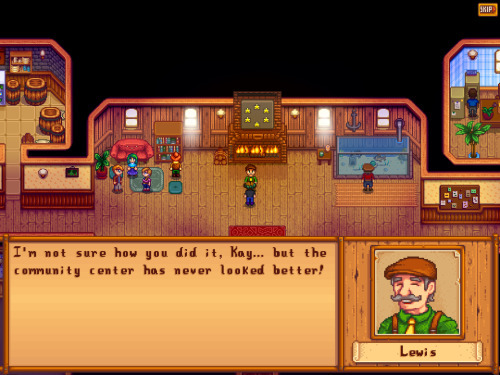
my cauliflower got stupid mchugelarge?? i do not know why they did that. also a meteor fell on my farm and gave me a bunch of really valuable ore, just like real life meteors.
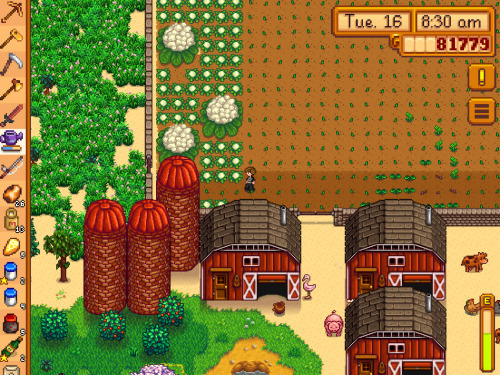
i do kind of regret picking the beach farm bc so much of my day is spent watering, but i am trying to lean harder into animal products and being more of a fun silly flower farm instead of the intense agriculture i find myself doing. i have the greenhouse, i have a small patch of sprinklerable land, i will simply make sure to buy some of every seed each season and if i really need something i will toss it in the greenhouse.
-
making
people are being very gracious about their mediocre colored pencil portraits. most of my gift budget this year was two flat rate boxes to my siblings. silly little pet portraits are very cost effective if you already have art supplies, nice paper, gumption, and very cheap small frames.
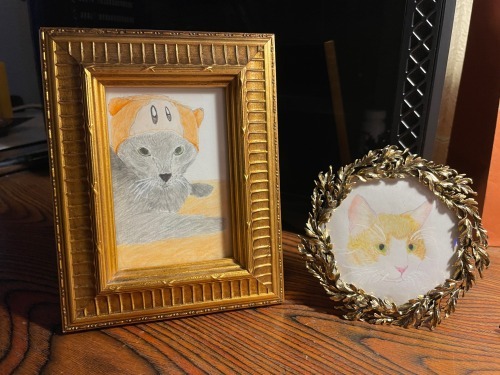
33 notes
·
View notes
Text
In the wake of finishing Dragon Age Veilguard, I've been thinking about what adventurers do when the world is saved. What does life look like when you return home carrying all the baggage you collected on your journey? How do you just live a life after that?
I think about this a lot in the context of one of my tabletop characters, specifically my Pathfinder 1e paladin. Callais spent a wild six months chasing a death cult intent on resurrecting Tar Baphon (think PF1e's version of Vecna, to be overly simple with it). Over the course of this adventure, she made a personal enemy out of a demon lord, was anointed the mortal avatar of her deity, purged an entire village of old god worshipping murderers, and learned her father was the vampire king of the country's capital -- which is a bit awkward when your goddess is staunchly opposed to undead. Those are just the high points and all before the party even faced off against the death cult's leader.
After all of that -- and then some -- she's just supposed to go home and be a wife and mother? Does she just lead sermons in the church or play the dutiful housewife? Where does her armor go? Where does her sword rest?
Basically, how does one retire after you save the world?
And I've been kicking around these thoughts quite often in the last few days when it comes to my Rook -- and not just because of the startling parallels between her and my Pathfinder character. My friend knows exactly what I'm talking about.
Some games give extensive enough epilogues that you don't really need to have these questions. Veilguard is not one of those games. (For the record, I love Veilguard despite and sometimes because of its flaws. And I will not be engaging in a debate otherwise.) And I love that I lived to a time when fanfiction is more common and acceptable. So, I can fill in these blanks. We are all filling in these blanks. I might some day when the horrors of holiday retail aren't doing their best to break me.
But you know, I just wanted to ask the question. What do you do when you wake up the next morning and you don't have to kill a god? When you don't have to fight an archdemon or prevent some world ending catastrophe? What do you do the day after that?
How do you find purpose in the wake of victory?
23 notes
·
View notes
Text
Silent Hill 2 commentary: Wood Side Apartments (1)
youtube
PREVIOUSLY ON: "IT’S. FINE. I am not deeply upset about this at all. I’M. FINE"; repairing the jukebox, James’ memory, the secret in-joke of "Anam Cara," an area I STILL hold a grudge about, and a flawless run to Wood Side
Spoiler policy: Just about anything but That One Big Thing near the end of the game, particularly information about characters, their motives, and their dynamics. The game’s eight endings may also be discussed. Content notes are below the cut.
Content notes: For this video as a whole, we have discussions or mentions (not visual depictions) of terminal illness, infertility, bullying, fatphobia, suicidal ideation, an article graphically describing a suicide, animal cruelty and death, and sexual violence against women (in the context of a Pyramid Head scene and, briefly, the film Blue Velvet).
Onscreen, there is a lot of vomiting, both human and monster this time. Bathrooms are generally disgusting. The Pyramid Head scene is intended to look more sexual than it actually is, and after it plays, I discuss why.
The combat involves body horror, acid vomit, realistic amounts of blood, and some oversized insects to crush. You may consider it violence against women, and I discuss that at the end of this first post and in the corrections video. We start out with a wooden plank, then get a handgun later in the video.
As I've mentioned before, @idoherty451 and I are sort of commentating loops around each other, which means that we're at a point where I recorded the Wood Side area first, Ian got that video early, then he did his own playthrough for Wood Side while referring to mine, and then I took notes on his for this writeup on mine, which was recorded first. It works for us, idk.
00:00: My dog Cooper is not here to get upset today; he's off having a bath and a trim. Meanwhile, we're going to meet our first mannequin, and I warmed up with a combat comparison—but more on that in a minute.
00:42: I was so proud of my Secret Goya Painting discovery—and so appalled that I forgot to go back and mention it—that I created a little sidebar post for it.
02:00: Third order of business: I saved over the version of the game that y’all watched—the commentary video is fine, but I lost my progress with all the collectibles. Turns out, if you hustle and don’t give TED talks on flower symbolism, you can play the entire game up to this point, and collect everything, and kill everything, in 90 minutes. For my trouble, I ended up a bit ahead on health items, so it worked out.
05:00: I love the mannequins so much. (I used to chirp "I love you!" now and then after defeating them, and then I heard it on video and realized it was... kind of creepy.) As much as I loved watching Let's Plays of the game, the mannequins were what finally tempted me into playing it for myself—and I wanted to let the first one we meet have show off her (their? its?) skill set a little. Just before this recording, I took about ten minutes to try out Light Combat vs Standard Combat:
youtube
I want to specify here that I’m not clutching my pearls about the mannequin’s, uh, smother move; I’ve already played the entire game once through and I’m used to fending it off. No, I was appalled that the mannequin opened with a power move—NO, we are NOT playing the rest of Wood Side on Standard if you’re gonna be like that.
So then, for this final recording, I repeated the comparison. I’d thought maybe it might be fun to just play this level on Standard—just Wood Side, because FUCK fighting Pyramid Head on this difficulty—but honestly, I get a little bored when I watch other players spend hours just whacking away at the monsters. I think Light Combat is a good level of suspense without being draggy while I’m also trying to talk. So over these two little exhibitions, you get to see the mannequins show off their bobs and their weaves, and you also get to see why I can’t bob their weaves 300 times.
08:20: So, the mannequins are a monster/enemy that consist of two pairs of legs joined symmetrically at the waist; one pair serves as arms, and that pair has no feet (and therefore no "hands"), so they just punch you with their ankles. Listen, I don’t know. They’ve been freshened up for the remake by original designer Masahiro Ito, and combine aspects of actual mannequins, Ashinaga-Tenaga from Japanese folklore, and orthotic devices Mary would have worn during her illness (or the concept of them; we never see this). They also have bandage-like foot wrappings that I think tie into ballet and the Dance Company we passed—and James’ interest in legs, apparently. (I feel like "having a video game made about you, airing out all your personal kinks" must feature in a minor circle of Hell.) I just love the mannequins because they are so SASSY; they pose and prance and rattle like snakes before kicking your ass. I didn’t go into this at full length in the video, and I wish I had, because I love them.
09:15: "I love you!" I would ask for their autograph except… awkward.
As you see here, fighting a mannequin on Standard Combat takes a fairly long time, and they do a lot of damage pretty quickly. Which is great, until you have to fight two of them at a time, and maybe a nurse with a knife and a couple of lying figures waiting their turn.
10:50: So now that I’ve switched to Light Combat—the "real" gameplay—let’s take our time, starting off with the James' Car Color oscillating fan in the corner (a symbol of cycles and repetition. No, I’m not making that up). I also point out that every single clock in the game is set to 9:10 and 15 seconds, which I’m pretty sure was Mary’s time of death. Keep that in mind.
Did not mention: After I recorded this, Ian found a book open on the desk relating to the "Stillness" ending; I haven't gotten the prerequisite "In Water" ending yet, so it wasn't present for me.
12:00: "Puzzles love a sheet." We unveil the coin puzzle, which is the organizing principle of the Wood Side Apartments level, and read the initial poem aloud. This might be my favorite puzzle in the game; the only one I like nearly as much is the gallows puzzle in Toluca Prison, and that's mostly because of the really striking cinematic at the end.
13:25: I walk us around to the mailboxes under the stairs. Every single time I've played this, I get to the "TO HELL" graffiti and involuntarily add, "...AND BEYOND."
"Administration Note": There are absolutely no guns in 217 (we will get our first gun in 217).
At this point, I see why I kept saying that "multiple notes" in South Vale referred to an emotionally unstable janitor: there is a Groovy Music janitor (who is running around town unnerving everyone, and who wanted to get out of town with a woman who may or may not have existed), and a Wood Side janitor who might be a completely separate being. In my heart, there is, in fact, one (1) mythical, roving, freelance janitor who might or might not be a Time Loop James.
16:00: I went back and recorded corrections for the second video after this, so you'll have heard me rend my garments about my wrongness before now, but I got very confused about the "leak" in Saul Street and the "flooding" in Wood Side. They are separate. The "leak" is the necrotic black substance associated with Pyramid Head; Wood Side has been flooded with actual water from the top down. Notably, James is associated with water, including rain, so flooding is "a very James thing to have happened, as opposed to a fire." Fire will turn out to be more of an Angela thing.
17:38: I don’t mention it, but when you hear loud noises or voices (like the banging right about here)—it’s usually caused by something (someone) you’ll run into later: the mannequin in a minute, the lying figure locked in 106, even Pyramid Head on Saul Street.
18:00: A mannequin rematch on Light Combat, which is over very quickly. That said, the mannequins seem to get more difficult to fight as the game progresses. Do not fear that this will get boring.
Interestingly, you can see that it's hiding in front of the vanity before you even pick up the flashlight. Very crudely brightened:

19:30: James: "These clothes..." I pull out the photo of Mary to compare: that’s her outfit on the dress form. I also point out the way a shadow covers the mannequin head on the vanity. We’ll talk about it at the end of the game.

All images are ©2024 Konami Digital Entertainment, and captured from my gameplay in January-March 2025.

Did not mention: That Mary's dress is a floral print, which is one of the reasons I associate her with with both flowers and floral fabrics, and also that finding the flashlight here means that Mary is a literal "Lady of the Light." (V1 1:47:00)
And here’s another Mary’s Time of Death clock (this building alone must have a dozen). I’d never noticed the birds on the (flowered) wallpaper until now—let’s call them “love birds”—and I think they connect to a pair of bird silhouette pictures in Apartment 201.
The real point of this room, by the way, is to pick up a key to the courtyard downstairs.
21:50: Side notes: Since the second recording, I've gotten my 100 seconds on critical health for the "In Water" ending; the record store easter eggs I mention are now on this post.
22:55: Apartment 201 is locked; it's our final destination for this level.
24:00: We head to the garbage chute courtyard. There’s a particular eyeball graffiti that repeats throughout the building; I’m guessing it’s related to the Cult Stuff eye symbol we see now and then.


Here's the broken garbage chute. "Please do not use until puzzle is solved." We’ll have to unclog that.
25:45: Apartment 112 has a very important article about a local murderer's death (content warning: a graphic suicide description, but nothing pictured). Walter Sullivan is the antagonist of Silent Hill 4: The Room (2004); I'm trying to forget what I read about it, since I managed to buy the restored game off GOG.com. Basically, I know enough about Silent Hill lore to be aware of what I don’t know. I know that various Pyramid Head-like figures who aren’t directly tied to James show up in other stories, and in this article, which appeared in the original SH2 as well, that's what Walter Sullivan’s "red devil" who wants to "punish" him seems to be hinting at. However, as Ian points out on his third stream, this is actually... not... what's going on, because SH4 takes this kernel of a story and goes somewhere else with it. But that's a discussion for another day. Right now, you need to remember this article about the Locane siblings' murder, because There Will Be A Quiz Later.
Meanwhile, there’s a strong argument made by both fans and Masahiro Ito himself (spoilers!) that Pyramid Head comes from James, is James, and can’t exist separately from him. But you try telling a video game company that they can’t reuse their most iconic character ("He's our Pinhead").
31:00: The Wood Side complex is more Mary's aesthetic (flowered fabrics and wallpapers throughout), whereas Saul Street might be more in tune with the janitor/James. "She" lives here, she who "washed it all away" (V2 1:32:20)—if she existed at all.
32:00: The oversized beetles that I keep having to whack into blood puddles are “creepers.” I kicked this topic over to Ian, and he confirmed on his second (and third) streams that they come from SH1. Me in the Twitch chat: "Well take them back."
32:45: Apartment 109. I turn off James’ flashlight to see how much is visible in an apartment lit only by a window covered in newspapers. A crouching mannequin, it turns out! This is why the Saul Street Note (V2 1:16:52) suggested staying in the dark: they don’t attack until light shines on them (or you just get too close).
I talk a little about the weird sounds the mannequins often make—giggles, sighs, girlish yelps. It’s honestly really disturbing—intentionally so, and we'll talk about Team Silent's approach with that at the end of this video. I think they’re meant to sound vulnerable and/or sexualized, to highlight that the monsters generally are (I think) sexual fantasy images come to life in mocking, aggressive forms… and that they may have more humanity than James wants to admit. (V1 1:07:36)
34:45: Why are the windows covered with newspaper? What were the tenants—and shop owners downtown—trying to keep out? Light? In a town now covered in fog?
35:05:"No, I didn't know I was bisexual, I had no idea. [But] I was practically a softball lesbian" is a comment that felt clumsy and weird to me even at the time—first of all, I guess it's entertaining that I was a plaid-wearing, softball-playing Melissa Etheridge and k.d. lang fan as a teenager, yet I didn't know I was queer. But I don't give you that context, and so it sounds like I don't know the difference between "bisexual," "lesbian," and "stereotype," and—I don't know, it's the kind of awkward comment that probably didn't actually offend anyone, but you lie awake at night because you have anxiety.
So I sat there and asked myself, why did I feel compelled to blurt this out? Well, in Video 2, I was arguing that, IMO, the lying figures and mannequins have "sexualized" features, but they're not "sexy" or titillating in the moment. My feeling is that these are things (women's legs, high heels, etc.) that James thinks about, but he's ashamed that he was mentally (or physically? we don't know?) cheating on his terminally ill wife, and so these fantasies have manifested in ugly, aggressive forms to taunt and confront him. These monsters having sexualized features but looking unpleasant is part of the concept. And I felt compelled to say, basically, I'm a person attracted to women, and so I can attest, they're not "attractive."
Which might have made sense in that moment. Then, in this third video, I suddenly bring up being queer again for no real reason... except that I've just finished talking about the sexualized noises the mannequins make. And I think a question had been simmering in my mind for a while: I've been warning for "violence against female (?) creatures." As a woman, I tend to identify with female... beings?... and the fairly realistic combat has made me a little uncomfortable while playing this game (yet I cheerfully keep playing it). But now, as of that second video, I've aligned myself with James, the source of this violence, as A Person Attracted to Women. How much does that change my place in the "violence against women" dynamic? (Does the combat being self-defense change anything? How much of it is self-defense?) I don't know. And I feel like more experienced gamers must be rolling their eyes like, "Why are you trying to make this into a thing? It's not that deep." I mean, it's probably not. It's survival horror; beating monsters to death is just what you do. But I feel like Silent Hill 2 is a really interesting, thoughtful game that invites you to think about these things. It raises some questions that make me uncomfortable, and I think it's supposed to, and... I like that. So rather than hope nobody noticed I said something supremely awkward, I'd rather say, you know, this is what the game brought forward for me. And like I said the first time I explained this, I don't have any answers. The questions feel valuable nonetheless.
Then I basically recited this material for the corrections video... and had to fight lying figures immediately afterwards, which maybe makes my point better than anything I could say here.
Next post: James' feud with a grade schooler, decorative storytelling, our first encounter with Pyramid Head, and the scariest scene in the whole game.
(SH2R commentary master post)
14 notes
·
View notes
Note
Hey, I uhhhh, had a fun little idea for a Yandere!Naoto x Non-Binary reader scénario where the reader ends up downloading a seemingly innocuous dating sim set in Inaba with Rise, Yosuke, Kanji, and Naoto as the main romance options (With Yu as the stand-in Protag). Things start off normal until the game starts acting weird and corrupted, as Yu suddenly starts to take features of the player (Who’s has curly hair with glasses) and Naoto suddenly shows signs of being self aware. Even after witnessing the corruption of the game due to the detective’s influence and later deleting it, Naoto still continues to haunt the player and try to escape their computer (Basically a mashup of DDLC and Ben Drowned)
I hope this wasn’t too long and I hope you have fun with it :).
Okay, so this is a big ol’ experimental one. I tried a new format and I tried to just...really tap into some ben drowned energy. That being said! I do NOT think I succeeded. But hey! It’s just an experiment, and I had a good bit of fun trying to write it! I will acknowledge though, I may have missed some parts of the ask. I hope you enjoy it regardless!
CW: Yandere vibes, I tried to make it creepy. Invasion of privacy is also a thing.
March 21st
Hello! I am starting this blog as a way to catalogue the weird events that I’ve run into while playing that indie game Inabi in love, which I will likely shorten through this ordeal.
Anyways! To start, some context: I am a pretty avid Otome/dating sim fan. Cooking companions, I love you colonel sanders, or DDLC are prime examples of the official ones I’ve played, but I’ve also played fan games, like that Thief of Hearts dating sim Robbing the robbers, or Five nights at love. Long story short, I have played plenty of dating sims, and some of them have been horror. So, I am not a stranger to the genre and the twists on it.
So, when my best friend bought me Inaba in love as a gift, I thought it would be nothing but a cute new game to pick up. The issue was...it’s been a bit weird? I think it’s too long to post in one big post at this hour, so I’ll get into the rest of it tomorrow, but be warned, this gets very weird, and I know how insane this sounds but it’s true. Please at least humor me while I fight my shitty wifi and buggy ass computer.
March 22nd
Hi! I return after a good night’s sleep. Now, let’s try to get into this again.
When I booted up Inaba in love for the first time, I was on a discord call with the friend who bought me the game to give them my initial reactions and things were perfectly normal. Like with most dating sims nowadays, there were two gender options, a bowl cut-having male lead with the personality of a brick, and a matching girl with similarly gray hair in twin braids. They were cute, bland, the perfect projection. Nothing weird there. I chose the male lead for a first run on my friend’s encouragement and I went on.
Next up, I met the love interests. The first one was the mc’s best friends. Chie to start, and she’s a perfectly cute girl, very tomboyish, and less annoying than the male romance option that I think was named Yosuke. Who, by contrast, didn’t strike me as a character I’d enjoy. I thought at first that he’d fall into that whole character trope of cutesy clutz. But, he ended up proving to be pretty cute in the end, so it’s fine.
In terms of love interests, the wild shit happened when I met the final love interest, Naoto.
Now, please know, I am cutting out a lot of content to keep things short. This isn’t a review of the actual game, I am moreso venting about the creepy shit I’ve run into, and that only really started when I met Naoto. Not at first, of course, but it didn’t take long.
At first, Naoto was fine. He was quickly my favorite, smart, funny, mature, I thought he was great. I locked onto his romance route the moment I was given it, and I had fun for the first two or so dates. However, on the third date, things began to get a little weird. Naoto admitted to checking my criminal record. Which, is fine, he’s a cop, I expected that.
What I didn’texpect, was that Naoto would continue that trend of kinda? reasonable, but creepy shit.
On one hand, it made sense, he’s a cop character, he’s gonna do background checks, but the fuck type of lore did I miss to explain why he admitted to keeping a file on me on the fifth date? Also, some of the stuff he listed from that file, like my name, work history, school history, none of that was put into the game. That’s also not just stuff from my steam page, so where the hell did the game pull that information from?! Where on my computer did it get that stuff about me? My socials? Can games do that?
I have to end this here, though. With my first post, the site’s tab on my computer closed itself and I actually lost that entire post and had to rewrite it a lot faster. I want to make sure I don’t have to do that here too. I’m already red flags on that end, so uh...I’ll return with more!
March 25th
Okay, I return after a small break. I’m gonna stop summarizing the game as a whole. Outside of Naoto being weird, the game’s your general otome game. You go through your day and talk to your romance options, trying to get dates and give them gifts. I mostly want to vent and maybe warn? About Naoto’s behavior. Which, by the way, doesn’t stop just in the game. I took those first two days off of the game to type up those posts, and by that point I had locked myself into his route. That’s how I know all about this stuff, but I don’t think I’ll continue it now.
At first, I thought it was just in-character. Naoto was stated to be a cop prodigy, so it made sense that he’d be able to do a thorough background check on the lead. But then he has a file on the main lead. Which, I know doesn’t sound insane, but this game’s lead is stated to just be a transfer student. I’ve tried googling and researching, but nothing I’ve found has implied or stated that the lead has some secret dark past, so I have no clue why he’s got a whole file. What information do the cops apparently have? Again, what lore did I miss? I tried looking up whether there was some subtle morality system built in, but no one mentions anything like that, so I’m just left to assume Naoto has a file on the male lead’s boring ass life. Why?! That’s creepy as hell when I remember the fact that this character also uses my own information.
But! I’m getting off track. Back to the creepy antics that have killed my urge to complete Naoto’s route. Like how the mc’s design had changed when I opened the game next! (No, I will not elaborate beyond he had the same hair color and texture as me)
Like I said, I took a two day break to write out my first two posts, and after that, I returned to the game. I mostly only did it to try and double check which date I was at with him, but as soon as I ran into him, he blew up on me.
Naoto snapped at me for abandoning him. Leading him on, being a flake, stuff like that. Which confused me? Because when I’d left the game, he was in a good mood, the date at his house had gone great (once I got past him commenting on how my yard is, trust me guys, there’s too much unnerving stuff to put in this series. I’ll probably follow it up with some bullet points at some point.) So, I had no clue how he knew I’d called him a creep? Does this game check your socials in real time? That’d be a really good horror game trick, but this was an otome game, and one that wasn’t marched as a psychological horror like DDLC, so I don’t know why that’d be programmed in. Which, is why I’m done.
A fictional character shouldn’t be able to just dothat, a main character shouldn’t alter his appearance mid-game to look like me, and I got really creeped out at him being so mad that I’d posted about Love in Inaba and his romance route. It feels invasive at this point, and I’m just...gonna delete the game. I suggest that if any of you want to buy this game, maybe don’t? Or, maybe wait until the developers explain this. Because, if they programmed their game to dig around in socials and computers, they’re at least insanely good at their job, or creeps.
For now, I’m gonna cut this post here. My laptop’s been kicking itself off of the wifi when I post stuff, so it’s been annoyingly touch and go just writing this lol. Also! That reminds me!
If you’ve sent me a DM in the last few days, about my post or the game, I promise I’ve seen the notifications, but when I’ve gone to check, nothing’s shown up. So, please feel free to try again, I think this site is bugging out.
I’m sorry if this little vent thread isn’t very good, or thorough on what exactly is creepy about the game, so I’ll go ahead and give a small bullet point on some of the small ways Naoto’s been creepy. I’ll come back to wrap this up and probably go into more detail there as well. Consider this a little appetizer while I try to recall more.
Naoto mentioned the state of my front yard
He mentioned my family in an attempt to get closer to me
On date 3, before I’d locked into his romance route and was also talking to Chie, Naoto got a bit jealous and mentioned where I’d taken Chie for lunch in the game.
The apparent real time reading of my social media
Naoto interrupted and seemed to basically chase Yosuke off when I tried to further his romance route.
He knew what I had for lunch
And this is all just the stuff I can comfortably blame on the game. I’m starting to suspect something supernatural’s going on with my laptop. Because the wifi wasn’t thisbad before, and tabs don’t just close on their own.
April 2nd
Hello! I return once again! I sadly won’t be listing issues I’ve run into with my partner, I just thought I’d post once my wifi had stabilized and assure you all that I’m doing fine. Please don’t actually DM me, I’ll be fine and am plenty happy. I’m no longer scared of that silly game, I’m sorry if I creeped any of you out, I just fell for the game’s tactics. Don’t mind this post, I’m sorry lol, it’ll be down soon.
#Yandere!Naoto x reader#Persona 4#persona#Naoto Shirogane x reader#Yandere#Naoto Shirogane#Yandere!Naoto Shirogane#scenario#ask#x reader#gender neutral reader
9 notes
·
View notes
Text
Jarod and Lola
A small rant fueled by a dubious take I heard on Jarod and Lola's relationship in both the game and first book, I've never fully read About a Girl so I can't vouch for that one.
((Now that I think about it, the OP was probably from a troll but it's too late I'm in too deep))
That being said. Spoilers.
TW for abuse and a brief talk about implied SA
Did Jarod abuse Lola in some way? It's likely, especially considering he slapped her in the first book. While it only happens if Lou decides not to do anything, it shows that Jarod is willing to hurt his child.
To be clear: hitting your kid is never okay. Even when he's trying to get her out of a dangerous situation, it's clear that smacking her did nothing, and that it wasn't an accident. It was retaliation for pushing off his hat. The direct quote is:
"The man’s long and thin fingers are clutching Lola’s bright red arm. The kid continues to flail, knocking back the man who loses his hat in the process. His response is immediate, a slap hard enough to knock her head off her shoulders." (31)
Lola's response directly after doesn't help
"The man sits at the wheel of the cab, and leers at Lola who flips him off. Once the car is gone, she stands up and dusts herself off." (251)
No reaction. We don't know what Lola was like before the Brigades, but I think anyone would be at least somewhat shocked after their parent hit them if it wasn't normal. Even if it was the first time, it's still entirely unnecessary. This was put there for a reason--to depict what kind of a person Jarod was before the attack. It shows that Jarod is not an innocent man who was pushed over the edge, and wasn't exactly a shining beacon of good or even halfway decent parenting before Lola's death.
Even without this, we already know Jarod is an objectively bad person. If we take away the nuance, he's still at his core a scary fictional bad guy who has it in him to hurt his daughter and kill people if they annoy him too much. So yeah, it's not out of the realm of possibility that he abused Lola even before the Brigades, and might have contributed to why she left. This is reprehensible on its own.
HOWEVER
It's okay to like Jarod and find him interesting, he's meant to be the archetypal stranger you shouldn't talk to in horror movies (the hitcher), and plays that part well. It doesn't make you a bad person to like Jarod. Look at it this way: just because you like the Joker doesn't mean you're gonna get a clown mask, rob a bank, then burn the money.
Back to Jarod though. I think if he did anything else, it would've been implied. If they wanted to go that way with his character (SA), I feel like it would be kind of irresponsible of the writers to leave it at small 'hints' (that for the record aren't really there). Making a shrine for your dead daughter isn't weird; the 'shrine' was in front of what was basically her bedroom--something parents of dead children tend to keep untouched. Being obsessed with your dead daughter, while probably unhealthy, isn't weird.
Just because Jarod has a short fuse and likes to threaten and kill people when his cold anger meter breaks doesn't automatically mean he gets some creepy sexual pleasure from doing so. It isn't implied like, at all. The closest things I can think of that's even remotely iffy without context is Better Be Good To Me, but even then it isn't about the crosser, it's about the cop.
TL; DR: Jarod, from what we know in canon, probably physically abused Lola before and after she joined the Brigades, however, there isn't enough evidence to say the writers (both book and game) wanted Jarod to be read as a sexual predator. To be clear: It's fine if that's *your* personal interpretation, as at the end of the day its art, but trying to stand on a moral high ground about a fictional character for something that was never remotely implied in game is really...yeah.
19 notes
·
View notes
Text

My coral island farmer OC, Fazlyn Dirynhai Base on the convo, interaction and behavior , these are her character I came up with all info i have at the time. So Imma gonna put it here for the record for future reference?? since the game have presented main personality through text, context and subtext a lot. I need to keep track of her somehow. [contain SPOILERS about questline/heart scene, convo, interaction] Here I go.
She likes starfruit. (; Luke Convo)
She can eat raw vegetables like eggplants. (; Luke and Raj Convo)
She likes making joke and puns. (; Interact with people's room and shop)
She can be 'respectful', rarely. (; Interact with Mollie's closet)
She talks a lot, even with someone she barely know. (; Leah and Mark convo)
She's yogi (; Ben convo)
She likes romantic homey dinner kind of date. (; Answer Pablo Question)
She likes eating flower than admiring one. (; Answer Scott Question)
She can be unintentionally flirt sometimes, but it just being nice in that case. (; Answer Mark Question)
She usually collapsed at night from exhaustion (; Behavior)
She worked in art field before. (; Answer Zarah Question)
She likes gossip, sometimes, of course *wink* (; Bree convo)
She can drink alcohol in little amount (; Scott's heart scene)
She likes horror movie(; Rafael's heart scene)
Other info about her.
She remembered Alice and Lily when she arrived. (; Alice and Lily favorite shown since we arrived to the town, before the farmer spoke to both of them.)
She didn't remember Nina, but they were childhood friends. (; Nina's questline)
Her name isn't her given name. (; Raj Convo). // I came up with the story that her legal name come from her nickname and her old first name, it started from she had the same name with her classmate. So, she's the one with the nickname for convenience. Then after that she kept found the incident recurring a lot, so she changed her nickname to her legal name for good. Her old first name is Lyn.
Speaker in Luke's shop is easily broken, she used to buy that speaker's brand before and it's broken in 6 months. (; Interact with top right shelf in Luke's shop.)
She also owned a clock like the one Luke sells back in Pokyo. (; Interact with bottom left shelf in Luke's shop.)
She tasted Betty's soup without permission. (; Interact with the pot in Betty's kitchen.) [imo, i want to smack her hand for that.]
Her vow in her wedding with Luke was 'Luke, a lifetime is not long enough for me to wake up every morning next to you.' (; Married day, obviously.)
Anddddd, these are my headcanons for this character. Just base on my random guess and thoughts.
She was closer to Alice than Suki when they were kids.
At some point, I think Nina, Luke, and farmer had played together, but it just 1-2 times, so only Nina can remember that. Since Luke is too young to remember the farmer and haven't been contacted with, and the farmer played with Nina more than Luke and she still didn't remember her, she doesn't good with remembering and such.
Suki, Alice, Nina, Lily and the farmer was a childhood friend group.
She hadn't talked with Tavern siblings or blacksmith brother before, from the first convo they had.
Her hair and her blue eyes come from her mother side, her mother is from San franciskyo
Her grandparents who owned the farm are on her father side, so they should be Indonesian(?).
Her parents met in Pokyo and she grew up there. That's the reason she had Pokyo accent from Leah's convo.
Her first talk with Taco, the dialog is like, '[He smells a lot like Luke]', but she hadn't speak with Luke at that point. So, she kinda buffled a bit. 'Wait, who's Luke??'
Her first rescuer for collapsed after 2 AM is Luke, I remember this because it's happened in 2nd Spring in the Year 1. So, in Year 2, the farmer gave him the locket that day, 2nd Spring.
2nd Spring in Year 3, she changed her hair as celebration of sort?? idk, it's pretty coincidence. I just wanted to change something a bit about the hair and just noticed that it that day. huh.. Wonder what will happend if I continue playing until next year.
#spoilers#coral island spoilers#coral island#coral island oc#coral island farmer#for future reference comic or so
24 notes
·
View notes
Text
The Record of Stan Frederick: A Study of Amendments
This is an analysis that is long overdue. If there’s anyone in the world that could tell you how much I love The Record of Stan Frederick, it’s my best friend whose ear I’ve talked off endlessly about it, and they would probably tell you that Amendments is not only my favorite episode of the series, but also that it’s my favorite Slenderverse video of all time. If anyone who hasn’t experienced the Slenderverse asked me to show them one video from it that would paint them a picture of what the spirit of this universe is all about, this is the one I would point them to, because its characters, story, and editing encapsulate everything that I’ve loved about the Slenderverse for years all in one episode. I believe that Amendments is not only just a brilliantly made episode among many others in The Record of Stan Frederick, but it is also crucial to our understanding of the narrative, of what both separates and brings together our primary protagonist and antagonist, how the events of each character’s lives and how they felt about them affected their choices, and how the overall story of this series promotes the cautionary tale of not letting yourself fall into perpetuating the cycle of violence.
This is a case study of Amendments.
In the context of The Record of Stan Frederick, the dictionary meaning of the episode’s title would be defined as “a change made by correction, addition, or deletion” as our protagonist Stan Frederick’s goal in this particular video is to correct his error of putting off stopping his ex-partner in crime, Connor Dwight, from hurting the people around Stan when he had known how to stop Connor for at least a year. Stan put everyone else’s monsters ahead of his own, which only led to further destruction that could have been avoided—yet another huge mistake that cost him greatly. With his metaphorical will to live gone when he lost Willow, a child Stan was trying to help who was being hunted by the monsters known as Seedeaters, who manipulated her sister Dana to give her over to them—an event that Connor had a hand in tricking Stan over after being given Willow’s death prophecy by another monster known as the Rake, in which Connor proceeded to give Stan a warning ahead of time that other characters they knew could be the next to die, but never gave Willow’s name as an option—Stan finally worked up the nerve to take care of him once and for all.
Stan returns to his childhood home years after the loss of his little brother Erik and his parents, the place still as empty as it was then, save for the monster who took them all, standing at the top of the stairs waiting for him like it had never left. The Slenderman, as we know him, a monster who Stan used to fear so much and once gave into survival to appease it, and now Stan needs its help. It’s such a cruel twist of fate when he had taken everything from Stan in the past, and he has to question it: Can the monster feel emotions like pain or fear, and do the things that it does mean anything in relation to what it is? The reality of this question is to wonder if this faceless being who never speaks its mind has any level of consciousness humans can understand. Is it just a monster meant to prey on people like an animal for its own survival? Is it meant to play games with the mind until its victims are broken and nothing more? Is it something so far removed from us? Or is it like us at all, able to understand the horrors it puts humanity through, but does it anyway? Could it ever have felt the pain that Stan felt every time it took someone from him, and could it have ever understood him? But they’re questions that never come with an answer. It does what it does and that’s all we know.
But there is one other thing that Stan knows: how to please it. He makes a deal with Slenderman, not a far cry from making a deal with the Devil, that if he would make Connor human again so that he can be killed, Stan would let Slenderman take him in return. Turning the corner up the stairs, Stan finds that Slenderman has disappeared at the request, and at first believes that this was a denial of the offer on the monster’s part, only to look back down the stairs and see him now at the bottom instead. The deal Stan made effectively reversed their roles where Slenderman went from being both literally and metaphorically above him to being below him, showing that Stan now is the one who has control over the monster, it doing his bidding instead of the other way around—a relatively uncommon thing for a protagonist of the Slenderverse to make happen. This is one of the many things that makes The Record of Stan Frederick unique in general, because the story is told from the perspective of someone who has already been through this and knows the monster’s behavioral patterns instead of someone who has never had these experiences before.
With his deal accepted by the monster, Stan enters his old bedroom with only his camera that he sets up on the windowsill, and Connor’s gun. For a moment as he loads the gun, he thinks back on the last conversation he had with his brother Erik the day Slenderman took him, a memory that we as the audience also hear, before putting the gun to his head which lures Connor out. The trigger is pulled and despite the gun being loaded, no bullet comes out, because Stan isn’t allowed to die. The Rake still owes him for having given Connor to him years ago, and Connor can’t kill him because he’s under the Rake’s protection. Similarly, Connor can’t be killed in his current form as what’s known as a corruptelam—an echo of a person much like that of a ghost that can be left behind when a monster consumes a human. So with the two of them now standing face to face, both unable to be killed by the other, they’re finally at a stalemate. This is also reflected in the framing of the scene in which neither character stands above or below the other, showing that they are currently equals, unlike before for example in the episode People where Connor stands over Stan and Serena after fighting them off.
This is when Stan tries to appeal to Connor’s emotions, asking him if he remembers when they first met and saying that he knows Connor forgot a lot of things. It’s unspecified just how much Connor did forget as the type of corruptelams Stan had described the Rake leaving behind being echoes of the body rather than the mind, the type which Connor is, but we do know that day was one of the things he seems to have forgotten. Stan reminds him that they were once just kids in the foster system, both afraid of the same monster and the only ones who seemed to have been followed by it, which is when they clicked. And interestingly enough, for a second, Connor almost seems… sad. He bows his head and stares at the floor, and Stan mirrors the same position. Mirroring someone’s behavior in psychology is often a sign of empathy, giving the other person a non-verbal sign of connection and understanding, and it’s often something subconsciously done in our every day social environments. It shows that both of them are in sync, engaged in the same discussion and nostalgia of the past they endured together.
Stan didn’t know anything about Connor back then, certainly not what he was capable of becoming, but he knew even less about what he himself would become and what they would become together. Fear drove them both to survival, as equally guilty in what they did as they are in their equal inability to die. It’s what they both wanted at one point, to be able to live without that fear. To want to survive is human; when we’re faced with death, most of us will do anything to stop it, just as they did. But sometimes we go about it in a way that brings harm to others. Sometimes we become selfish creatures and throw others to the weeds if it means we’ll get a good night’s sleep. The truth is, the only thing that makes Stan better than Connor here is the fact that he woke up one day and realized he didn’t want to live that way anymore, to hurt others to keep himself safe. They’ve both been victims and they’ve both been perpetrators, but only Stan broke that cycle.
Stan then lifts the gun and points it at Connor, who reminds him that Stan can’t kill him. Stan replies that he knows because Connor is a corruptelam, the phenomena which he had named himself, to which Connor points out that he finds this whole situation embarrassing. This moment and the moment before are so surprisingly human, taking a step back and looking at the portrayal of Connor’s character up until this point as an otherwise threatening and intimidating figure. But, being completely unphased by the gun, Stan wonders if Connor had forgotten that, too—how to be scared, knowing now that he can’t be killed as a corruptelam and feeling that nothing bad would ever happen to him again because he’s something stronger than a human now. This conversation perfectly mirrors Stan’s earlier questions to Slenderman of if he can feel emotions and if the awful things he does have any purpose relative to his being, because Connor has truly become their own monster: perpetuating the cycle of violence, taking what he can from Stan to hurt him, and now unable to die. He’s forgotten the times that he used to lie awake in bed every night, terrified that their monster would come back again and harm him, and that’s something he outright tells Stan. “You move on. You make it better for yourself. You forget!” he argues. “No, you don’t! You don’t forget that,” Stan responds. “I certainly don’t. I forgot a lot… But I would never fucking forget that.”
To remember our fears, in Stan’s eyes, is what keeps us human. It’s what reminds us that other people in our own personal situations have the same feelings as us, and makes us ask what right we have to make them suffer while we find peace. What makes us our monsters is not the hardships we face, but the hell we choose to make others go through to feel better about ourselves, and we have to be careful not to cross that line. We are all as capable of continuing the cycles of torment we experience as we are capable of breaking them, and Connor unfortunately never did.
It’s at this point that Stan allows Slenderman to complete his request, to turn back the clock and make Connor human again. Connor falls to his knees before his monster and screams as Slenderman does this, remaining on his knees even when it’s over and Stan points his gun at the back of Connor’s head. This scene shows that their stalemate has finally been broken with Stan now being above Connor rather than on equal ground with him. Connor begins to make one final plea for his life, but Stan cuts him off by shooting him, ending his life for real this time. Blood covers the screen, hiding Stan’s face from view as he too falls to his knees, now becoming his monster himself. We can no longer see his expressions beyond the blood, we don’t know his exact thoughts, if he feels better for taking Connor out of the world so he can’t hurt anyone else, or if he feels more grief for having to take his life with his own hands this time around—having also been stated in one of the book excerpts to have hated himself for giving Connor over to the Rake originally—or if he’s feeling some strange mixture of both. We don’t know what his emotions are toward that action in that moment, just as we don’t know what Slenderman’s emotions may be when he hurts people, if he even has any at all. There’s only emptiness left in the silent room that we as the audience feel, until Stan leaves Connor’s body behind for the Rake to find and goes back downstairs to accept his fate in giving himself over to Slenderman, completing their arranged deal.
Except he doesn’t.
As Slenderman tries to take him, Stan talks back, explaining how Slenderman used to be so huge and terrifying to him as a kid, and how he took everything from him. He asks the monster then if he really thought that Stan was going to let him take him too before using the same gun he had just killed Connor with to shoot himself, finally able to die as he was no longer in the Rake’s good graces. A body for a body. And not to get all David Kushner’s Daylight here, but that gun, too, is a metaphor for how Stan and Connor drinking poison from the same vine of survival led them both to their deaths. It was Connor who owned the gun first, the person who also initially suggested the idea of sacrificing other kids to their monster in return for their own peace, which Stan agreed to. The blood from the same deal they made was always on both of their hands, but Connor choosing to share that poison with Stan made Stan his own undoing from the beginning as he would always be the one to stop Connor. The awful truth is, if not for Stan, Connor’s way of surviving may have been proven to always work. It’s a horrible way to go, but no one else ever brought him down. If Connor truly wanted to survive in that way, picking Stan as his survival partner was the wrong move, unbeknownst to him at the start. The gun is a symbolic reflection in this scenario of Stan’s original plans when he had initially accepted Connor’s proposal of harvesting—that he was going to poison his and Connor’s cups of coffee which would kill them both, stopping Connor from going through with perpetuating the cycle of violence and ending his own life because he never stopped feeling guilt and grief from losing his brother to Slenderman.
The narrative actively punishes Stan whenever he chooses to live, and fate seems to scream that he has always been meant to die that day with Connor before they could ever do any of the horrible things they did together. Whether that be the time he handed Connor off to the Rake and got to live again only to be stuck trying to make up for their mistakes, or this time in Amendments when Stan returns as a corruptelam for one last try at making something of his life and he loses the last of the people that he loved, it’s always a punishment that he doesn’t die. He committed unforgivable sins that he could find no redemption for unless it was to choose death, and there was never another option to redeem him. The tragedy of The Record of Stan Frederick is like something out of a Shakespearian play, that there is no atonement and no end to Stan’s suffering unless he dies when all he wanted to do before was get out alive—just as his favorite song said. Amendments perfectly conveys the message of this story like no other, that becoming your own monster can only lead you down two paths: one of a never-ending cycle of hurting others to feel better about yourself, or one of never-ending regret. There’s no hope in that cycle. But there is hope in reaching out to others for help when you need it, and that is part of the message, too. After all, it’s Stan who tells his support group in the episode titled Support Group that they have each other and tells them how important that connection is. The support of those going through the same troubles as us is meant to lift us up, to help us survive together in a positive way, not to abuse and exploit it as Stan and Connor once did. It’s up to all of us to decide which path we’ll choose, and it’s up to us alone to accept the responsibility of those actions—just as Stan finally did.
#Stan Frederick#The Record of Stan Frederick#Slenderverse#I've been working on this all afternoon and now I can't see because I've been staring at my screen too long#worth it#I feel like I should have a tag for my analyses and essays at this point but I don't#and here I thought I'd never be writing essays again after high school but apparently I'm neurodivergent about fiction so here we are
29 notes
·
View notes
Text
There is a popular quote attributed to both Fredric Jameson and Slavoj Žižek arguing that it is “easier to imagine the end of the world than the end of capitalism.” It is an odd thought to process while watching Rhys Frake-Waterfield’s Winnie the Pooh: Blood and Honey, a schlocky horror film that reimagines A. A. Milne’s loveable anthropomorphic teddy bear as a hack-and-slash movie monster. Still, it’s something that bubbles through the film’s very existence. Blood and Honey can be understood in a couple of different contexts. Most obviously, it is a transgressive horror film that uses the iconography of beloved childhood figures in a grotesque and unsettling way as a shortcut to cheap thrills. There has been a recent spate of these movies, including The Banana Splits Movie and The Mean One. Later this year, Five Nights at Freddy’s will adapt the beloved video game, riffing on the same basic idea of cute childish things turned violent. However, Blood and Honey stands apart from these contemporaries. It isn’t a pastiche like Five Nights at Freddy’s, it isn’t a licensed production like The Banana Splits Movie, and it’s not an unauthorized parody like The Mean One. It is an adaptation of A. A. Milne’s beloved children’s classic, made possible by the fact that Winnie the Pooh has entered the public domain. Nobody has to pay to use the character, and no authority has the power to veto what can be done with him. Copyright law is an interesting thing. The Copyright Act of 1790 enshrined legal protection of an author’s right to their work for “the term of fourteen years from the recording the title thereof in the clerk’s office.” However, that period of protection would be expanded over the ensuing centuries. With the Copyright Term Extension Act, arriving in 1998, that protection was extended to the life of the author plus another seven decades. Of course, the reality is that copyright doesn’t always protect the artists. It often exists to enrich corporate entities. Much of the most lucrative intellectual property on the planet is controlled by faceless companies that ruthlessly exploit the artistry of their employees and contractors. Comic book movies are a billion-dollar industry, but key creative figures have to fundraise to pay medical bills, like Bill Mantlo. Creators like Jack Kirby or Bill Finger never got to enjoy the spoils of their labor.
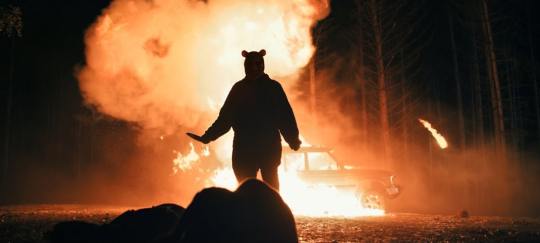
Indeed, these extensions to the period of copyright were largely driven by companies holding these intellectual property rights. The Copyright Term Extension Act was known in some circles as the “Mickey Mouse Protection Act,” reflecting Disney’s proactive lobbying in favor of the extension. Incidentally, Disney paid $350 million to buy Winnie the Pooh from the A. A. Milne estate in March 2001. It is ruthless capitalism, rooted in these companies’ desires to control the public imagination. The Copyright Term Extension Act ensured that no media entered the public domain between 1998 and 2019. As much as writers like Grant Morrison might argue that superheroes are the modern equivalent to the classic Greek gods, this ignores the fact that mythology is a public resource. The classic myths were not owned by large corporations that could use the threat of legal action to pull Vera Drew’s The People’s Joker from the Toronto International Film Festival after a single screening. This makes Blood and Honey a pointed act of transgression. The film comes from writer and director Rhys Frake-Waterfield, best known as a producer of low-rent schlock like Dinosaur Hotel and Dragon Fury. Realizing that A. A. Milne’s beloved childhood fable was entering the public domain, Frake-Waterfield sensed an opportunity. With a budget of under $100,000, he set out to make a quick cash-in slasher movie. Of course, Frake-Waterfield could only draw from elements included in the earliest stories. He had to avoid the iconic material added to the mythos in the years that followed. “Only the 1926 version is in the public domain, so those were the only elements I could incorporate,” Frake-Waterfield admitted. “Other parts like Poohsticks, and Tigger, and Pooh’s red shirt — those aren’t elements I can use at the moment because they’re the copyright of Disney and that would get me in a lot of trouble.” Blood and Honey is a bad movie. It is lazy, uninspired, and boring. It has no sense of character, theme, or basic structure. It’s a lazily reskinned version of Halloween or The Texas Chainsaw Massacre from a filmmaker who spent a significant portion of the press tour passive-aggressively complaining about how Halloween Ends took “itself too seriously.” There is nothing of any merit here, nothing to hold the audience’s interest. The film’s 84-minute runtime lasts several lifetimes. That said, there is a germ of an interesting idea in the central concept, which has an adult Christopher Robin (Nikolai Leon) returning to the childhood fantasy that he abandoned to go to college. He discovers that his childhood did not take well to this abandonment. Winnie the Pooh (Craig David Dowsett), now a feral and mute beast, chains Christopher up and tortures him. He whips the adult with Eeyore’s tail. However, Winnie the Pooh cannot kill Christopher. He must possess him.
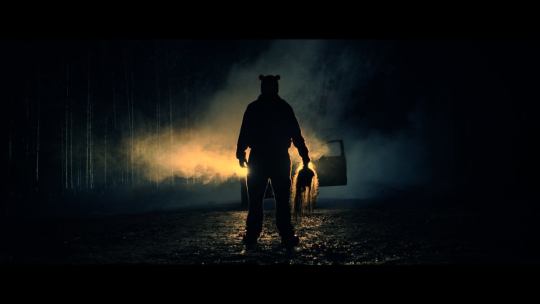
It is too much to suggest that this plot is mirrored in the story of the film’s actual protagonist and decoy final girl, Maria (Maria Taylor). Maria is taking a trip into the country with her girlfriends, recovering from a traumatic experience with a male stalker (Chris Cordell). When Maria’s friend Lara (Natasha Tosini) spots Pooh lurking around the Airbnb, she assumes that he must be Maria’s stalker. Pooh’s psychopathic sidekick, Piglet, is also played by Cordell, to underscore this connection. At times, Blood and Honey seems like it might be a clever and subversive commentary on the way in which so much modern pop culture infantilizes its audience. Christopher has tried to grow up and leave his childhood behind, even planning to marry his fiancée Mary (Paula Coiz), but his childhood won’t leave him behind. Pooh needs Christopher, his validation and his love. However, that relationship is not as innocent as it appears framed through childhood memory. Many modern adults would empathize with this idea, as their childhood nostalgia is weaponized against them by streaming services and studios. Even if one lives in a remote cabin in the woods, franchises like Star Wars, Teenage Mutant Ninja Turtles, He-Man, and X-Men: The Animated Series are inescapable. Entertainment that was once aimed at children is now aimed at the adults those children became. There is no indication that these corporations are ever going to stop. Of course, this gives Blood and Honey too much credit, suggesting that it can be read as a subversive commentary on the role that this sort of intellectual property plays in cultural stagnation. In reality, Blood and Honey is an illustration of just how pervasive this model of capitalism can be. Frake-Waterfield isn’t using Pooh to make a point about the cynical exploitation of these cultural touchstones. He is using it as a cynical exploitation of these cultural touchstones. Blood and Honey grossed nearly $5 million at the global box office, and one suspects that it performed very well on home media and streaming. There is already a sequel in the works with “five times the budget.” More than that, Frake-Waterfield has made a conscious effort to expand the brand into a shared universe built around similar properties. He will direct Peter Pan’s Neverland Nightmare and will produce Bambi: The Reckoning, which was sold to international distributors at Cannes this year. Frake-Waterfield doesn’t just have his eye on these sequels and spin-offs. He dreams of a bigger childhood horror shared universe. “The idea is that we’re going to try and imagine they’re all in the same world, so we can have crossovers,” he boasted. “People have been messaging saying they really want to see Bambi versus Pooh.” It’s incredibly ruthless and cynical. It is a transparent attempt to build a massive multimedia franchise from elements that the production team don’t have to pay for.
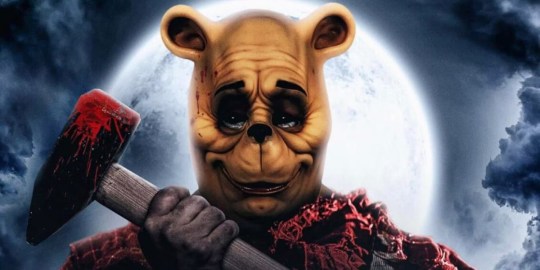
In theory, the liberation of these iconic characters from copyright should herald encourage creativity and ingenuity. It should allow for more projects like The People’s Joker or Apocalypse Pooh. There are certainly artists engaged in that sort of work. It also provides the opportunity for commentary and engagement with the modern media landscape. Last Week Tonight with John Oliver is already salivating at the satirical potential of Mickey Mouse’s entry into the public domain. Blood and Honey suggests an alternative to these creative uses of works leaving corporate purview. Blood and Honey is just as cynical and ruthless in its exploitation of this intellectual property as Disney had been. Frake-Waterfield is clearly aspiring to exploit these properties in exactly the same way that Disney did, hoping to create a scale model of their production machine. It is a trickle-down shared universe, a reheat of a familiar meal constructed from pre-digested ingredients. For all the moral handwringing about how the movie “ruined people’s childhoods,” this is the real horror of Blood and Honey. It suggests the limits of creative imagination, an inability to conceive of an alternative to the model of intellectual property management that defines so much contemporary pop culture. The roots of this mode of thinking run so deep that it seems impossible to imagine any alternative. The public domain doesn’t free this intellectual property from endless exploitation, it just means somebody else gets to take a turn. If the rights to Winnie the Pooh are entering the public domain, why wouldn’t somebody use the brand recognition to make a quick and easy buck? After all, the business logic behind Blood and Honey is the same logic behind something like The Little Mermaid or Ant-Man and the Wasp: Quantumania. People recognize the brand, and that will make it easier to sell. Even this seemingly subversive and rebellious act is just a cheaper, more cynical, and less competent iteration of the larger processes that drive modern media. All things considered, the cynicism of Blood and Honey is a small price to pay for the possibility of more work like The People’s Joker. More than that, if it helps to undermine or shatter the brand loyalty that these corporations have cultivated among generations of movie-goers, it may serve some purpose. Still, it’s disheartening to watch Blood and Honey, realizing that these modes of exploitation are so deeply ingrained in pop culture that they perpetuate even in the public domain. Even as the end of copyright becomes a reality, the end of this intellectual property churn remains beyond imagination. Oh bother.
107 notes
·
View notes
Note
4, 7, 14 for the mi ask game!!
SIL!!!! Thank u for these delicious asks. I’m about to go ham.
Mission Impossible Ask Game
4. What is your all time favorite mi scene?
The vault scene 😭 but if not that, then hm! Okay. That is so fucking difficult. I spent my entire workday trying to answer this.
I’ll go ahead and say that the stretch of MI3 where Ethan is inconsolable about Julia’s kidnapping. Specifically that scene where he’s pacing back and forth in front of Luther, distraught over every minute on the clock. He literally panics when a minute passes! Teary-eyed, choked up, and overwhelmed. That’s how I love this man B). He’s pregaming grief even though he’s trying to save her, nobody talks about how fucking phenomenal that performance was!
7. Who is your favorite underrated mi character NOT of the main team?
Nyah, hands down. She’s so fucking overlooked in the greater context of the series. The OG thief girlie. “Do you mind if I’m on top?” and SO fucking real for that. She is a character who was put in a situation beyond her control, and who tried to navigate it for the right reasons anyway.
Peel back the whirlwind romance for a second: Her ex-boyfriend was a maniac trying to gas the continent and sell the cure back. The IMF saw her nothing more as a body for bait, rather than a competent thief as they led Ethan to believe initially. She listened to her conscience and entered a dangerous situation, rightfully pissed and fucking nervous. She injected herself with a bioweapon to buy Ethan time. She slapped the shit out of Sean, who had a fucking gun and any number of ways to make her suffer for it. She was ready to kill herself to keep Chimera from spreading and killing others. She’s brave, she’s witty, she’s skilled, and she’s vulnerable. Also she’s drop dead gorgeous so jot that down. NOBODY was serving like Ms. Hall. I’m so sad TC’s control freak tendencies fumbled Thandiwe Newton 😔 we could’ve had it aaaaaaallllllll. Rolling in the deeeeeeeeep
14. Do you have any mi headcanons?
I DO!!! Since I brought up Nyah in the last question, I’ll just jot some down for her.
My HCs:
She grew up poor and was a painfully shy child.
She still has nightmares about Chimera sometimes. Her most common one is where she’s wandering in the heart of Sydney and everyone is running away. Nyah cannot remember where she is or how she got there. She pleads for help, and everyone she encounters screams in horror. She sees her reflection in a store window, and staring back is the living dead. Next thing she knows she’s falling, falling, falling. She wakes up on impact.
Nyah was a gifted ballet student. It was the One nice thing she had as a child that didn't go when the hard times came, it was the only thing she could keep for herself. She dreamed of the russian ballet and learning from the greats, becoming one. She wanted it SO bad, the dream of dancing out from obscurity and being poor. But elite ballet school tuition when you’ve got nothing? A real dream killer.
She started stealing for survival, but she got /good/ at it because she felt she deserved better. Turns out that being light on your feet lends itself well to stealth.
Miss girl does NOT wear lab diamonds.
‘Why would a girl like her date someone like Sean Ambrose?’ Listen. He was interesting, intense and most important: unpredictable. She’s prone to boredom. His highs were high and his lows were low. He was charming and adventurous and exciting. Unfortunately, he was also clingy and possessive. Never the twain shall meet.
Nyah is bisexual. Duh. Also she likes long hair on her partners
The IMF caught up with her eventually, despite clearing her record at the end of 2. They did it knowing she wouldn’t stay out of trouble for long, because old habits die hard, and Ethan taught her how to hide, but not how to run. She was offered The Choice. The thought of just rotting in jail out of spite crossed her mind, but her hair would look dreadful and she cannot have that.
After MI2, she and Ethan developed a code word for when they cross paths. The word is ‘adamas’, Greek for ‘unbreakable’ or ‘invincible’. You know what else is unbreakable? Diamonds.
6 notes
·
View notes
Note
Do you think it would be cheap if it's revealed that the monsters slaughtered in the video game of chapter 3 of Deltarune turned out to be living beings in a later chapter?
Apparently in the code, the sprites within it are denoted with "sword_route" similar to "weird_route". This lead me to theory that the game is meant to be a manual on the ways to fight against the prophecy. The weird route for board 2 where Noelle becomes stronger by freezing Darkners, and a route where Kris becomes stronger by killing monsters that seem to be hiding from them in the shelter in board 3.
Kris gets caught in a slippery slope by allowing themselves to kill things they don't see as sentient (slain counter appearing in chapter 4 if you beat the Titan Spawn with violence instead of pacifying them, Ralsei views the Titans as beings they must fight since they can't be reasoned with), raising their LV, and becoming more easily controlled. Whereas against Darkners they always held back so they wouldn't kill them even if they fought with violence.
Kris fighting so hard to protect their friends from being manipulated by the Soul, believing they can counteract its influence, only to realize they'd fallen into a trap. It sounds pretty sick as a route. And during their finak fight with Tenna, if you played the video game, Kris is indicated to act aggressively towards Tenna in dialogue, so this might be showing the start of the fall on their own sword.
However, going back to my original point, do you think it'd be cheap if it was revealed the monsters in the video game were actual living beings?
To me, I took the game as something left for us by someone (likely Gaster) to show us ways to go against the prophecy. I never saw killing the things within it as killing living beings, but apparently the game records a kill count in the code if you do the game. And that has me worried we might be later judged for doing that, a la Sans in Judgment Hall.
I was fine with that in Undertale, because if you listen to the game, it's pretty easy to avoid being judged negatively if you just listen to what the game asks of you. Whereas here, it doesn't feel clear at all. I feel like it's going to suck if it's revealed in chapter 5 or 6, years down the line, that they were living beings, and you unintentionally committed a genocide, and have to redo parts of the game.
And I think the thing that really turns me off such an idea is what about the arcade machine that blows up in chapter 2?
Why wouldn't you just view it as a game within a game like that?
Yeah, revealing years down the line that playing the videogame-within-the-game is actually going to mess up a "pacifist" route does feel like a cheap gotcha to me. Especially since playing the videogame is (near?)required in order to fight the secret boss of Chapter 3, when all the other bosses are fine to do (even advantageous to do) on a normal playthrough.
As much as Undertale/Deltarune like to mess with players' expectations, that feels pointlessly frustrating. It wouldn't say anything interesting thematically because (as you say), the intentions are confusing at best. A bunch of players who put time into defeating the Roaring Knight would redo their saves and skip that boss to be on the route they were intending, but afterwards everyone would just avoid interfacing with the game-within-the-game at all.
I think a Kris-like character being lulled into killing beings they didn't realize were sentient could work in another game… but in the broader context of Deltarune, I don't see the point. Kris is already a very morally ambiguous figure, at times seemingly antagonistic to the Red SOUL, which made a lot of people think they were evil from Chapter 1! And the Weird Route already exists as the true "slippery slope into horror"-type story. So what would such a "Kris becomes evil because they murdered videogame people" route add that is different?
I do think the game-within-the-game is meant as a manual. But the theory I'm more inclined to subscribe to is that the "sword_route" is wholly a guide for the Weird Route, foreshadowing future chapters for it while also acting as an in-game hint for people who play Deltarune without looking up online guides. (And which I'm very happy exists, because the starting conditions for the Weird Route are so much more obscure than Undertale's comparable "secret bad ending". Being forced to look up fandom discussions to even realize an alternate route exists isn't great gameplay.)
If anything, I think it's more likely that those internal counters might eventually be relevant on the Weird Route, precisely because that's the "all bets are off, you need to do bizarre and un-telegraphed stuff in order to progress this" route. Maybe you do need to be as violent as possible in all situations for some later Chapter 5-6 condition, who knows. But at least that would feel less out-of-left-field.
…Or those counters could just do nothing, of course. Something something you can't change the ending. Or, for that matter, maybe Susie will be impressed by your cool skills later in another videogame if you played the game in Chapter 3.
We really can't say yet! So it's not something I'm worried about.
4 notes
·
View notes
Text
I've been in a bit of a Percy Weasley POV-reading mood and I haven't done fic recommendations in forever. That's not to say I stopped reading fics I think I just kind of forgot to do fic recommendations so here I am!
I have two of decent sizes. One is a crossover, the other starts off where it diverges from canon. Canon stuff still happens just not compliant with canon.
---
The Wizard Archivist of a Seemingly Muggle Institute by Pookily
Summary
AU. Percy doesn’t take the promotion from Fudge and ends up fired. But then he finds himself on the steps of a tall, white building in Chelsea and the signs tell him this is the Magnus Institute… . . . Percy’s life is in pieces, he’s fired from the Ministry of Magic due to his “misconduct” in the Crouch affair. To save himself from ruin, he takes the job as an Archivist in a seemingly normal Muggle institute, dedicated to research the paranormal and esoteric. But everything isn’t what it seems to be, Percy lands himself in a trouble far greater than just a workplace misconduct and a spider’s web is tied to him…
First is a The Magnus Archives crossover where after Percy refuses a promotion and ends up fired, he stumbles across The Magnus Institute and becomes the Head Archivist. Picking off around Book 5 of HP and leads into Season 1 of TMA. You don't necessarily need TMA knowledge as so far its seeming to follow season 1 (with some changes) and thus the pacing of how the characters learn about stuff over time. However, it'll gloss over statements that have happened in canon which might be a little confusing.
There's one work finished and another still in the works, having last updated August 29th, 2024, with 190k+ words altogether. It also contains major spoilers for the Hogwarts Mystery game which I don't think you need to have knowledge of already as part of it is also uncovering what happened in that game, it'd just probably enhance the experience.
In this fic, also, Percy happens to be a seer. (Also Jon ends up being like a Deputy Archivist and takes over if Percy for whatever reason can't so we still have all the season 1 team and Jon is still kinda a boss, the team just kinda has two bosses now.)
Notes when getting into it: - The Magnus Archives is a fictional horror podcast and has to do a lot with horrifying experiences and things that trigger fear. It touches on a lot of stuff but the main focus right now is.. Are you okay with worms? Because there's a lot of focus on worms in this part of the story and like them trying to get into your skin and it's pretty horrifying but if you read those lines and you just can't then I wouldn't recommend it. This also probably sounds really weird out of context. - The podcast basically records statements of paranormal things that happen, however in the fic of canon statements they get skipped over. If you want to find them yourself, be prepared for googling. Ignore the case number. Re-recordings of statements will have a "Statement of [Name Here]" and if you google it you'll likely end up finding the wiki page to which it contains a link to listen to the audio, read the transcript, and also see all content warnings for each episode. For live statements if you google the name you could also end up finding the wiki page for it (i would say add 'TMA' at the end just in case so as not to stumble on a real person) though characters that play a more active role in the story may be more difficult to find. Since we're at the beginning though it'd be easier to go to the character page and go to first mentioned and you'll likely find the statement mentioned there. - Knowledge of Harry Potter is most definitely needed. Hogwarts Mystery less so though there will be appearances of characters from that game and I wouldn't be surprised if you get confused on what's going on in that part of the story. - Original Characters do play a role in this story. - Characters from both fandoms do interact with each other and intersect, it's not just a one character goes to meet characters from a different fandom and they don't interact because they do, and it's more as if both fandoms lived in the same world and thus inevitably have interacted before the story begins. It does focus a lot more on the TMA side of things considering that's where Percy ends up working but HP stuff is still going on throughout this.
I think that's it? Anyway I might be horribly wrong and it might not be as new to TMA-friendly as I'm thinking it might be as I went into it mostly having all the relevant knowledge so it was a bit easier to follow for me.
-------------
like sunshine after rain by bookgrimm
Summary
Percy Weasley takes very poor care of himself. This is not a secret. Anyone who took one look at the Gryffindor’s Prefect can see that. Anyone who had ever encountered him during his late nights in the library can tell. Percy has an obsession , and it was very slowly killing him. Percy knows this, but it certainly hasn’t stopped him. ******* Or: Percy’s low self esteem and makes him the perfect target for the Dark Lord . ***** Or: Oliver wishes Percy would care about himself more.
Takes place in Book 2 of HP, Percy is the one who gets possessed by the diary instead of Ginny. He also realizes he's gay so if that's not your cup of tea, it plays a pretty big role.
Also the Weasleys aren't really the best. They're trying but they don't really realize what Percy is going through for awhile (in a they don't realize until something big happens and end up coming to their senses), so he's struggling a bit but he does end up making friends who are there for him.
Also there's bullying and homophobia. Percy's also pretty depressed and ends up hurting himself a few times. He needs a hug.
Two works, both completed, one about Book 2 events, the other kinda dealing with the aftermath and more. Together is 150k words and the last chapter updated December 2nd, 2024.
It has its fluffy moments but I'd be cautious regardless since it's a bit dark.
Anyway on the topic of Percy fics, I know there are some pretty long time travel ones out there, I just don't remembering reading them so I can't really comment. I think they're cool though.
I also think Seer Percy is cool but I also like Seer anyone so..
#percy weasley#not my fic#fic rec#fic recommendation#fanfic rec#fanfic recommendation#hp fic#harry potter fic#hp fic rec#crossover fic#crossover fic rec#fanfiction recommendation#tma fic#tma crossover#harry potter#the magnus archives
6 notes
·
View notes
Text
February recs (and unrecs)
Books
Ursula K. LeGuin: The Beginning Place. A short and simple portal fantasy, elevated by the complexity of the main characters, the depressing family dynamics they are stuck in, and the creeping horror of suburbia, contrasted with the leafy silence of the other place. There are beautiful plot twists handled so subtly and quietly, they don't feel like twists at all.
William Gibson: Neuromancer. The original cyberpunk heist story. This book borrows from many places, but holy shit everything borrows so heavily from this book. Ghost in the Shell, Matrix, Inception, Severance, Terra Ignota, everything. But even in itself, it's an epic that's both fun and disquieting.
Robert Musil: The Man Without Qualities III. A brilliant work that I don't quite recommend because it's extremely long and unfinished. The version I've read was pieced together posthumously from the author's drafts and notes into a Frankenbook that's weirdly paced and self-contradictory and reads like a record of a genius writing himself into a corner. Still, it's not his fault that he set out to write a book examining the causes of WW1, and before he finished the final volume, WW2 broke out.
Francis Beaumont: The Knight of the Burning Pestle. A fourth-wall-breaking play from 1607. A guy gets up on stage during the prologue, and demands that he gets his own plotline, even if it doesn't fit with the rest of the story.
Podcasts:
PBS, Adam Monahan: Detours. A behind-the-scenes podcast about Antiques Roadshow, always focusing on the story and context of a specific antique. You don't need to watch or like Roadshow to get it, if you're interested in getting a bite-sized pieces of completely random history, you'll like it.
BBC, Greg Jenner: You're Dead to Me. A podcast where the host invites a historian and a comedian to explore a historical topic together, (often a specific person, sometimes an era or an invention.) Funny and light, but still factual.
Ranged Touch: Homestuck Made This World. A long-time Homestuck fan and a confused newbie read HS together, but the stakes aren't just about liking or disliking it, these guys really go deep into trying to analyze what Homestuck is and why Homestuck is. Hilarious but genuinely enlightening on the nature of Homestuck and also media in general.
Fic (Homestuck fic reread, inspired by the HMTW podcast)
paraTactician: The Vienna Game. Not only a great Homestuck fic, with good plot, good prose and good characterization, it's also an excellent Neuromancer pastiche. The work of meshing the two types of worldbuilding together is gorgeous.
urbananchorite, Cephied_Variable, schellibie: Promstuck. The silly high school AU to end all silly high school AUs. The melodramatic moments are okay, but it's the unhinged chaos humour that makes this story worth reading. It's so good.
sonnetstuck: Detective Pony. I kind of recommend this one even if you haven't read Homestuck, it stands on its own fairly well. It's about a dude defacing a middle-grade book about ponies, and getting into unexpectedly serious metanarrative shenanigans.
Movies
SW: The Phantom Menace. Wow this was a much more enjoyable movie when I was nine.
SW: Attack of the Clones. Slightly better than I remembered, but still. Bad.
SW: The Clone Wars. The movie not the series. So bad, so heartlessly bad it makes the above two look like masterpieces. Only watched it because I'm interested in what the More Civilized Age podcast will say about it.
5 notes
·
View notes
Text
Silent Hill 2 commentary: Eastern South Vale & jukebox puzzle (1)
youtube
PREVIOUSLY ON: Out on the town. NG+ clues for getting other endings, highly symbolic scissors, James' amnesia, the sun mural & the Lady of the Light, lots to explore. Afterwards: corrections & additions.
Spoiler policy: Just about anything but That One Big Thing near the end of the game, particularly information about characters, their motives, and their dynamics. The game's eight endings may also be discussed. Content notes are below the cut.
Content notes: In this video, there's a lot of acid vomit and blood in combat, including the body horror of the "lying figures" (description written for the 1:06:00 mark), and at one point I discuss the idea of violence against monsters with sexualized/feminine features (this is purposefully part of the story, IMO). There's some oversized insects now and then (also blood). In terms of themes, I discuss suicidal ideation, alcoholism, drug addiction, terminal illness, infidelity, infertility—most of this is very subtle, and this is not one of the Huge Trigger Warnings videos.
I'll say up front, I roped @idoherty451 into doing his own commentary alongside mine. Ian's both a musician and a longtime Silent Hill fan, so he's specializing in music theory/storytelling and the context of the other Silent Hill games/lore. We refer to our email discussions a lot, I'm usually in his Twitch chat, and we've decided I'm just gonna straight-up be like "Iaaaaaan what is this?!" while I'm recording, as necessary. Our commentaries are sometimes kind of a conversation back and forth, and I like that. So this is the "Ian" I'm referring to throughout. (First stream; second stream.)
00:00: First: while I was reviewing the video to write this up, I realized that I misspoke about the Lilith graffiti in the first video (and then came up with a different interpretation). At the time, I had only posted the first video for Patreon, and I ended up tacking on a "corrections" edit before I made it public. So this is referring to the version that's currently up to watch.
Second, I mention wanting to record a sidebar about liminality, which I have not yet done as of this writing.
Third order of business: playing the game.
03:05: Picking up at the save point in Neely's Bar. We reread the note from the end of the first video: a man who is sort of a dream-logic reflection of James broke the bar's jukebox. The record store and an apartment complex are mentioned, implying that we'll need to go to both places to find what we need to repair the jukebox and the half a broken record left behind.
04:40: I cheerfully have a "radical acceptance of what a disaster I am" as I struggle with the interface.
In the previous commentary, I linked to a video by thegamingmuse about the "There was a hole here. It's gone now" graffiti," and I mention it at this point.
Did not mention: To be honest, I have since come up with an interpretation that I like better—not that multiple interpretations can't live in harmony—and that I think fits what we actually see onscreen. The short version is, there are mostly two kinds of holes in the game, and we'll see one of them later in this video: ridiculously deep wall holes that James has to stick his arm into, in order to fish out some quest item. (There's at least, I don't know, 4-5 of these throughout the game.) In the second half of the game, we'll also see multiple Alice in Wonderland-inspired holes he has to jump down in order to progress. James is visibly disgusted by the former and frightened of the latter. But he has to venture into and through these holes in order to find the answers he wants. He can't learn the truth without going into the dark. And it will turn out to be, after all, a very dark truth. (Not spoiling it.) But here in Neely's Bar, James can't remember things—to the point where he needs a jukebox to recall even a brief, pleasant memory about his wife. There was a hole here (memories, however dark, available in James' mind), but it's gone now. Imagine needing the dark to get enlightenment, and that's kind of the idea. So I think this is a fairly solid but also simpler interpretation, and sometimes simpler might be stronger.
For the record, Ian subsequently found (I nearly said "dug up") the original game materials' comment on holes as a motif, and it is, "the abyss which has opened up in [James'] heart" and "diving into his own subconscious" to accept his own wrongdoing.
05:00: Recapping the unseen janitor character as kind of a reflection of James or his feelings, in a dream-logic way: this subplot functions as a gaming convention, basically, to give us puzzle clues and guidance. We'll be looking for a missing jukebox button and the second half of a broken record, then fix the jukebox, and that's our quest for the South Vale level.
06:00: The theme of the puzzle: "Music will bring you back." James doesn't remember what he doesn't remember; music from the jukebox will help him remember time he spent with his wife and direct us to a future destination. Did not mention: There's actually scientific research to this effect, such as:
Why music causes memories to flood back (Washington Post)
Why does music bring back memories? What the science says (Durham University)
08:00: Leaving the bar for our next location: the Happy Burger. Outside, there's a newspaper box with the headline "Wood Side Apartments Severely Flooded," foreshadowing the next level; a pet care flier that alludes to the Pet Center and the "Goodest Boi" joke ending; and a Drug Hotline poster referencing a drug epidemic related to the cult that runs the town (see 39:00 or Ian's second stream).


I also talk about recognizing different types of monsters by the noises they make (we hear various squelching sounds the entire time I'm talking out here). You'll see this in the third video coming up, where I react to sounds in dark spaces before I actually get jumped.
10:50: Inside the Happy Burger, where a lying figure is on the floor playing dead. I talk about the lack of health indicators being immersive—we don't get health bars in real life. Instead, James' magical jacket gets a bit bloody around the shoulders, he staggers around, and there's a red vignette around the edges of the screen; these visuals intensifying, plus a medical plus sign in the lower right corner, are the only way you can tell how badly James might be doing. Did not mention: your controller (or gaming mouse, if applicable) changing colors will also indicate your health level, but I'm on a PC with a very plain external mouse. (I think controllers may also vibrate when the radio goes off?) All of this is customizable in the extensive settings—you can turn off the vignette if you want, and just rely on damage to James' magical healing jacket and the plus sign.
12:45: "I have a new theory": the Happy Burger has imagery indicating Maria (the Sexy Wife Doppelgänger we haven't met yet; see previous commentary), including a Happy Burger flier that reads, "Feel the craving?" and "What you need is what you get!" Which I think indicates temptation and instant gratification for a man who was frustrated during his wife's three-year illness. There's also a "Queen's Special" poster on the wall (but a clock with Mary's time of death as well).
Did not mention: I know I keep talking about Maria when we haven't even seen or heard of her yet—and we won't for a few hours more!—but I think talking about her well in advance actually makes space for the ideas that she'll emerge from, so that when she finally shows up as a manifestation from James' subconscious, it'll feel like she's materializing a little bit from our minds as well.
14:38: Battling two lying figures amid copious acid vomit. I have not yet warmed up for the day. In the audio I posted back in January from my first run, you can hear my attempts to lure the lying figures to better areas, which I didn't try to do this time because I was too busy running my mouth.
16:16: Discussion of James' magical healing jacket, which Bloober Team painstakingly obtained in real life and scrunched into a microphone for the perfect fabric sound effect.
18:45: Doing better outside with a lying figure. My dog Cooper shows up, upset—you can't see or hear him, but you hear me talking to him at various points from here on. "You will notice that I talk to James a little bit the way I talk to my dog." As I say a minute later, I realized that I don't call James "honey" the way his wife does; I call him "honey" the way I call my dog that.
Did not mention: The columned building is the post office, which I wasn't sure about at the time.
20:00: I stumble across something I had really wanted to find: a Dead James slumped against a semi-truck with two documents (written in blood?). Discussion of time loop theory: I like the idea that James has been living this search for Mary over and over, with both the collectible Glimpses of the Past and various corpses that look like James throughout town supporting this. There are at least two other explanations for those bodies, but that's the one I like.
But the reason I had wanted to find this James is to pick up a "Code Note" that describes trying to brute-force guess a four-digit code at Grand Market. I already knew the code from watching and playing the game previously, but for the commentary, I'd wanted to come by that information honestly.
We also pick up a "Sanders Street Note" (written in blood?) that says, "You will see. Sooner or later, you will see." Did not mention: In Ian's second stream, he pointed out that the smear on the back is Pyramid Head-shaped.
I mention that you often pick up notes/items at a price: some monster immediately attacking you. This time it's a slithering lying figure that rears up like a dolphin and headbutts James in the knee.
23:13: I had pointed out in the first video that the game tells you that white cloth marks "items and traversals you can interact with," and then it puts "white cloth" all over the rest of the game as well. Here's an example of that: giant white-cloth barriers blocking off various streets in town.
25:15: I couldn't remember what "Magical Envelopes" referred to. Ian answered this on his second stream: it refers to the way James received a letter from his late wife, who could not have possibly mailed something to him 1) without an address on it 2) while being dead.
25:50: Neely Street is named after pulp author Richard Neely, per Lost Memories: Silent Hill Chronicle.
Did not mention: I wondered why we have "black smoke-fog right there," lying low on the street. I think it mostly relates to the way that the lying figures' acid vomit dissipates into black steam.
26:45: Let's stop in front of the Dance Company. James kind of has a thing for legs, which you see in the creature designs. Like, I don't have a source for this, but we all just seem to take the idea on faith, because it's a pretty solid hypothesis. Regarding the Dance Company, the mannequins (which you'll see in the third video) have ballet-reminiscent wrappings on their feet.
In the "Leave" ending, James will admit that he had wanted to "move on with [his] life" during Mary's illness—an idea that shows up in this poster about dance lessons that will pair up singles: "No partner? No problem."
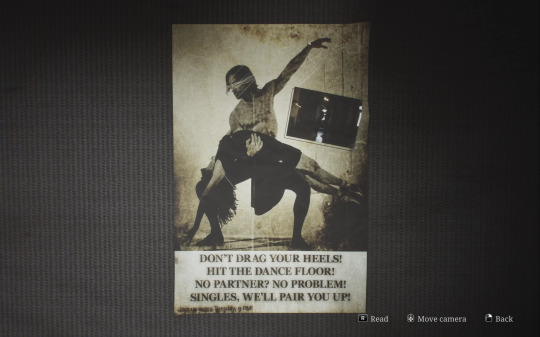
In his second stream, Ian asked if the inset photo, which shows a couple dancing, might be using the James and Maria models. Here it is, enlarged and brightened:
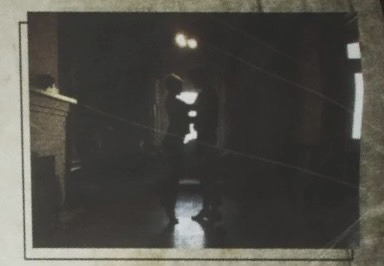
I don't think these two are actually James and Maria, but I think the woman being blonde (as opposed to Mary's brunette) is meant to evoke Maria the Sexy Wife Replacement, yes.
28:00: Silent Hill Fresh Meats, the butcher. Here's the first collectible Strange Photo, which I am 99% sure shows a room we will see at the end of the third video, in a Wood Side apartment (which I believe is either a partial or full manifestation of a place that James and Mary lived). See comparison below:


All images are ©2024 Konami Digital Entertainment, and captured from my gameplay in January-March 2025.
I kept forgetting the name of the redditor who solved the Strange Photos—it's u/DaleRobinson, and I have videos on my research playlist running through how this worked, as confirmed by Bloober Team. On the front, the picture seems to have four (4) sort-of film burn holes; the photo's caption is, "I've been happy." What DaleRobinson figured out is, you count the number of something on each picture, and you count to that letter in the caption: "I've B." On the back of this one, you see the number 6. There will be 26 photos total to collect, and you'll see them in numerical order in your inventory. Using this process to count which letter in each caption to use, DaleRobinson came up with the sentence,
"YOU'VE BEEN HERE FOR TWO DECADES."
The letter B is sixth in that sentence.
Later in this commentary (but I'll go ahead and write it up now), I gradually fumble towards the realization that the town may currently be frozen in the mid-80s, based on a pharmacy receipt dated 1982 and a calendar dated 1983. I had always assumed the story took place in 2001 (the release year of the original SH2) and James was wandering through a ghost town that had "died" and been abandoned decades before—but, as I say later in this video, the model and condition of James' car would make more sense in the '80s.
So what does "two decades" mean?
1) Some people believe it means that "you," the fans, have been playing this game for two decades (from the first game in 2001 to the remake in 2024), and it's a way to recognize the fans' loyalty.
2) Some people (including me) like the time loop theory (which has been a fan theory since the original game), in which case "two decades" would mean that James has been repeating the events of the game over and over for some 20 years... every time we play it.
At which point: what's the time frame of those two decades?
At first, I assumed James had arrived in this abandoned ghost town in 2001, and therefore he would have been looping this (roughly) 24-hour period from then until 2024, when the remake was released. Because the town isn't just abandoned; it's dilapidated and decayed. However, you could say that James arrived there in 1985ish, and the town froze in 1982-83ish and somehow rotted and decayed this quickly because this version of it is projected from James' subconscious, and "rot" symbolizes his wife's death, or even the breakdown of their marriage. (See the discussion of the "While I am decaying like a rotten thing" graffiti in the first commentary video/post.) At which point, James has been looping this experience over the course of the second half of the '80s and the full 1990s ("two decades") until the original players picked up the game in 2001. And maybe Silent Hill has just been revising the surroundings all that time to keep things interesting (especially since some of the Dead Jameses leave notes with helpful hints, which suggest they've realized they're not the first James and they won't be the last). And this is why James keeps finding Glimpses of the Past—things Silent Hill has moved or changed for him over the years, and that feel vaguely familiar to him.
I personally think the phrasing is "two decades" rather than "twenty years" so that it can fit both meanings—both James and the fans have been here. (Well, not me. I've only been here 4-5 months. And that's why I prefer time loop theory, heh.)
Let's end this first post here; we'll pick up with another Strange Photo and Your New Best Friend.
(SH2R commentary master post)
#sh2r playthrough#sh2r commentary#gaming#strange photos#time loop theory#silent hill 2 remake#long post#video
11 notes
·
View notes
Note
Not sure if you've ever made a post like this/someone has already asked this and you've answered but I was wondering if you had a list of J&H adaptions (of any kind and as well as other fans making things that are just online stuff rather than big professional things) that you really like and think people should get into if they haven't really explored or even know of just yet? I'm curious because I've only branched out a little bit and got some stuff that was fairly. Meh.
I have made a few posts about the matter but! I’ll gladly repeat myself.
the trick with finding good J&H adaptations is to forget about 1:1 plot accuracy and instead focus on theme accuracy. You’ll be pleasantly surprised to discover a lot of adaptations (including crossovers and pastiches) understand the book and what it’s getting at.
Here’s my personal list of recommendations:
-MazM Jekyll and Hyde: a Korean visual novel that adapts the book to a T. The main timeline (chapters 1-8) are free to play, but chapters 9-10 and a few other tidbits are very cheap. Since it’s styled like an RPG, you can talk to NPCs that will give you some insight in the historical and cultural context of the novella. It has a spin-off game called Hyde and Seek in which Hyde is one of the antagonists, if you’re interested.
-Le Testament du Docteur Cordelier aka The Doctor’s Horrible Experiment: originally released as a TV movie in 1959 but later released in cinemas, this Jean Renoir production tightly follows the book plot with very small changes. The biggest change is that the story is set in 1950s Paris rather than 1880s England, with all the characters having different names. It has a budget of five dollars and a shoestring but it’s very well written and well acted, with a professional mime playing Jekyll and Hyde. My friend @nemeyuko has a copy with English subtitles. WARNING: there is a rape scene near the end.
-I, Monster: a 1971 Amicus production (basically a knockoff Hammer movie) with Christopher Lee and Peter Cushing as the leads. Some character’s names and events are changed, but the plot is very much recognizable as a Jekyll and Hyde adaptation. The setting is also changed to the Edwardian period. This adaptation focuses on the psychological element of the story, including overt references to Freud and modern psychoanalysis, and putting the spotlight on Jekyll’s addiction to the serum.
-The League of Extraordinary Gentlemen: 2003 Norrington movie that has almost nothing to do with the comics it was adapting from, but it’s considered more enjoyable by most people since it isn’t as dark and gritty. I specially recommend the movie for its take on Jekyll/Hyde, since it doesn’t shy away from the addiction angle. Hyde is entirely done with practical effects. The movie novelization is available in the Internet Archive, and it has a bit more focus on Hyde.
-Jekyll and Hyde at the Old Vic: a dance adaptation that reimagines Jekyll as a dorky botanist in 1950s England. It doesn’t have any dialogue and it’s mostly about an angsty love story but I really liked it (basically imagine Jekyll and Hyde meets Little Shop Of Horrors, and I’m not exaggerating!). It was available for free on YouTube a while ago but it’s been taken down- if anybody has any recordings let me know!
I have a rather lengthy list of adaptations I’m watching on YouTube, a lot of which I haven’t even started yet (and a lot of which aren’t particularly worthwhile) but here’s a little documentary and a couple of funny sketches.
33 notes
·
View notes
Text
Stranger Things Runaway Max Review (1/3)
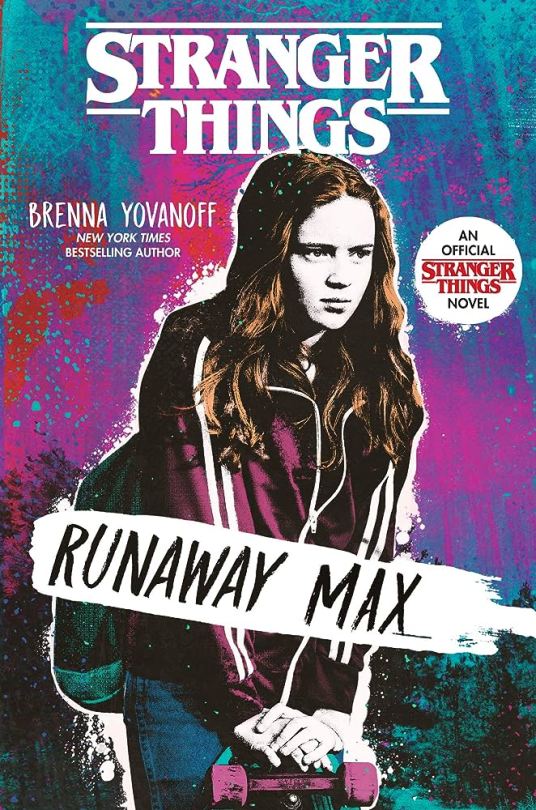
If you haven't yet, be sure to check out my other Stranger Things Reviews. Like, Reblog, and let me know what your thoughts are regarding the show or the upcoming season! :)
Stranger Things Comics/Graphic Novels:
Stranger Things Six
Stranger Things Halloween Special
Stranger Things The Other Side
Stranger Things Zombie Boys
Stranger Things The Bully
Stranger Things Winter Special
Stranger Things Tomb of Ybwen
Stranger Things Into The Fire
Stranger Things Science Camp
Stranger Things “The Game Master” and “Erica’s Quest”
Stranger Things and Dungeons and Dragons
Stranger Things Kamchatka
Stranger Things Erica The Great
Stranger Things “Creature Feature” and “Summer Special”
Stranger Things Tie-In Books:
Stranger Things Suspicious Minds
Synopsis: Witness the events of season 2 from Max's perspective as she recounts her past in San Diego, her relationships with Neil, Billy, and Susan, her subsequent move to Hawkins, and her meeting with the Party as Lucas invites her on an adventure that will change her life forever.
Observations:
For a book that's short and easy to read (only 231 pages), this was rough to get through. Not because it's badly written (if anything, it's arguably one of the BEST Tie-In novels for Stranger Things), but because this book delves into hard topics like abuse, depression, and isolation, and does not sugarcoat any of it. While Max never had a perfect life in California, the moment Neil and Billy came into the picture is the moment things went sideways for her. There were parts of this book that were distressing, and the way Max's story plays out in season 4 makes a lot of what happens here look harsher in hindsight.
I've said before in previous reviews that the supplementary material works better when it helps enhance the story and mythology of the show. To the book's credit, it manages to do that effectively. While it does retell parts of season 2 from Max's perspective, it gives the audience more context about her past, the circumstances behind Billy and Neil coming into her life, how she views each of the characters she encounters, and it allows the audience the opportunity to get to know Max better.
Part 1: Max And Her Monsters:
In my Creature Feature review, I mentioned Max had a love for horror movies similar to Will, and that Halloween was her favorite holiday:
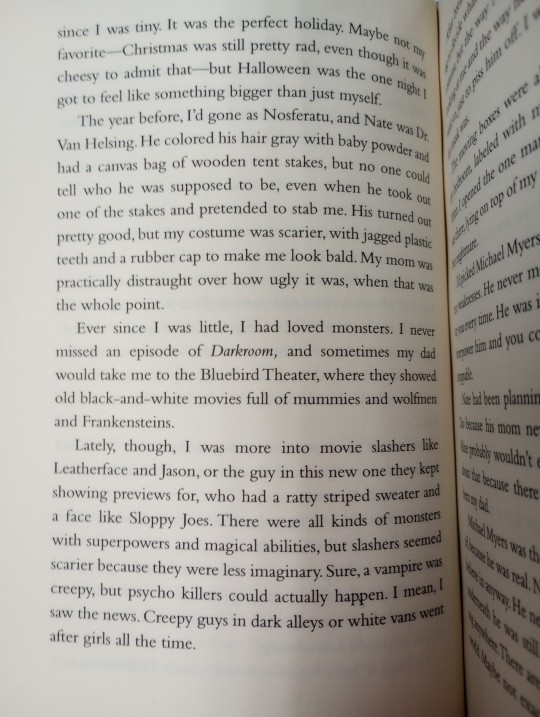
She even goes on record stating Michael Myers is the horror movie monster that scares her the most, and therefore fascinates her:

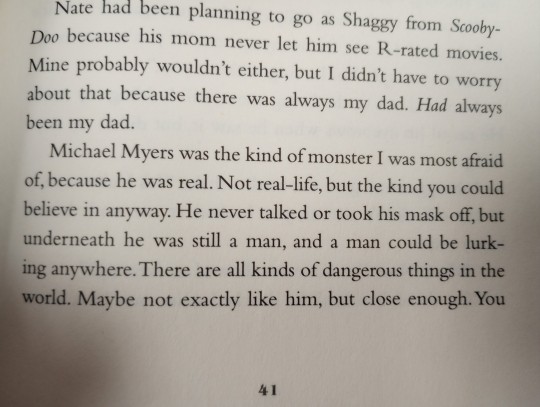
There's a dark irony in how Max's fear of Michael parallels her later fear of Vecna: Both of them are serial killers, both of them are mentally disturbed, both of them are strong and will do everything to hunt their targets down, both of them cause collateral damage in their rampages, both of them take heavy injuries and still manage to keep pushing forward, and both of them act as an unstoppable force of terror. The big difference is while Michael is portrayed as a physical threat, Vecna acts more as a supernatural AND psychological threat who can bring your worst insecurities and memories to the surface in order to drive you to despair before he consumes you.
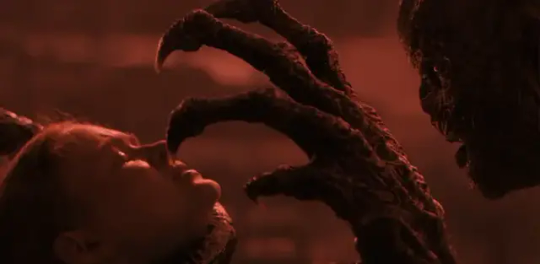
Max had an interest in horror/slasher movies, and then her life became one. Poor girl can't catch a break. 😞
Her love of horror movies predates Vecna and Billy, but there is something to be said about her fixation on monsters, and how she talks about them in context of her situation: In order for her to deal with monsters, she either needs to understand them and their mindset, or she needs to find some way to keep the monsters close to her so that she'll never be caught off-guard by them. There are several instances where she refers to Billy and Neil in this manner because of the abuse they inflict on her, and she desperately tries to understand their behavior as a means of coping with them:
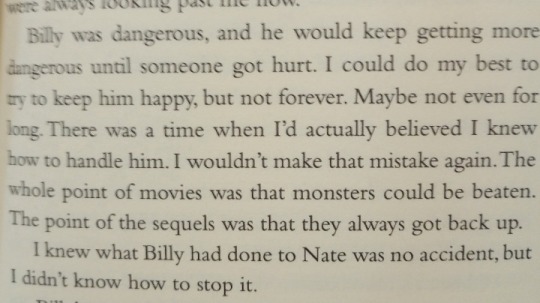
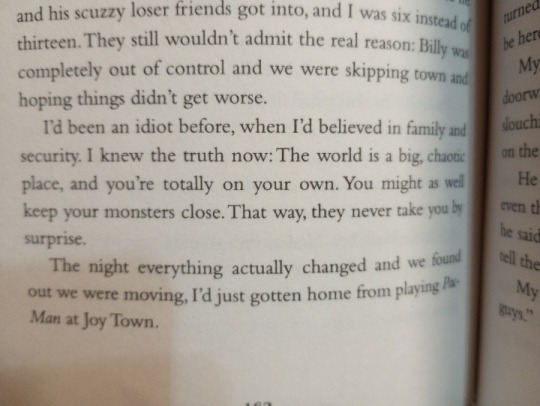
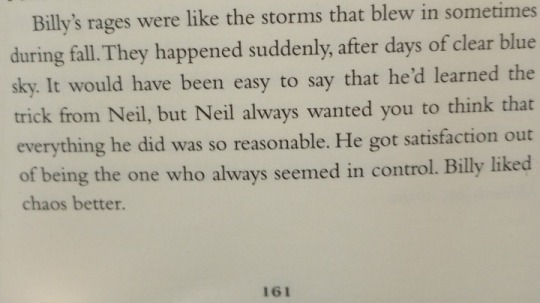
Anyone who's ever been in an abusive situation can relate to what Max is going through. She's forced to live with Billy and Neil despite not wanting to, she feels like no one (including her mom) is stepping in to make things better, and she initially thinks the only option is to weather the storm. She wants to "understand" how her monsters operate and keep them focused on her as a means of protecting others from getting caught in the crosshairs.
In a way, it's similar to her situation with Vecna in season 4. Despite Lucas's suggestion that they go back to Ms. Kelly's office to see if Vecna's targeted other kids, Max refuses because she believes she understands how Vecna works, and would have a better chance of dealing with him compared to a unprepared stranger going up against Vecna:
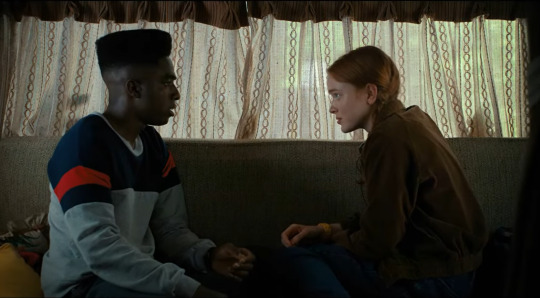
Max (to Lucas): We don't have time for any of that, okay? And even if we did, even if your plan did work, we'd be putting a total stranger at risk. A stranger who has no idea what they're up against. I do. He uses my memories against me. But… only my darkest memories. Same with Chrissy and Fred, right? It's like he only sees the darkness in us. So, I'll just run in the opposite direction. Run to the light. And maybe he won't be able to find me there.
Lucas: Now, how exactly do you plan on doing this?
Max: I'm not sure. But it's my mind. Not his, right? So I should be able to control where I am. I just need to… push him away. Find a happy memory and hide there. Hide in the light.
Max's arc has not only been about dealing with her "monsters," but also allowing others to help her and realizing she doesn't have to fight them alone. It's a new concept for her because most of her life has been her believing things would only get worse, and that no one would step in on her behalf. Given how her mom was complicit in letting Neil and Billy railroad their lives, it's understandable why she's hardened herself and adopted a cynical outlook. After Billy drives away Max's friends in San Diego and breaks the arm of her best friend Nate to create a wedge between them, Max loses hope that her living situation will improve, and decides she'd rather have Billy's rage directed at her instead of seeing others close to her continue to get hurt. The result is she becomes isolated, just like Billy wanted.
However, in spite of appearing closed off on the surface, people continue to reach out to her once she moves to Hawkins. Dustin and Lucas invite her to go Trick-or-Treating with them, and despite Billy later trying to run them off the road with his car, they still want her to be a part of their group. There's even a brief scene in the book (which should have been on the show) where Max gets injured while skateboarding outside of the store Joyce works at, and Joyce comes to see if she's okay. Max is surprised by this because it's one of the few times she's seen someone express any genuine concern for her:
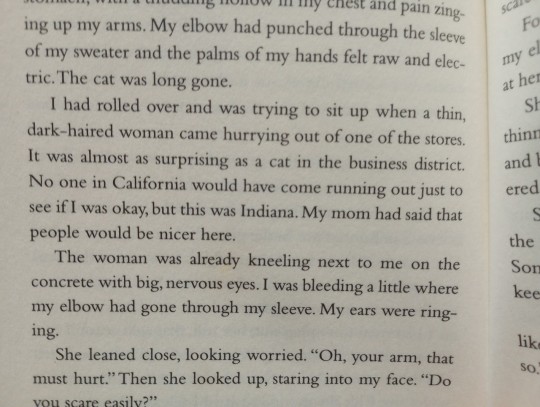
Later on, Lucas is ultimately the one who opens up to her about everything related to El and the Upside Down, takes her to the junkyard to show her proof of their story, listens to what she's been going through while reassuring her that she's still a good person, and takes the time to get to know her. And as Max sees from everyone else in the Party, despite their arguments and differences, they do care about each other and will fight for one another when the going gets tough. Lucas himself shows he's willing to fight for Max despite how scary and awful Billy is, and despite how standoffish Max initially presented herself. She's never truly had someone do that for her before, and witnessing that is what finally allows her to stand up to Billy at the end of the book and save Steve's life in the process:

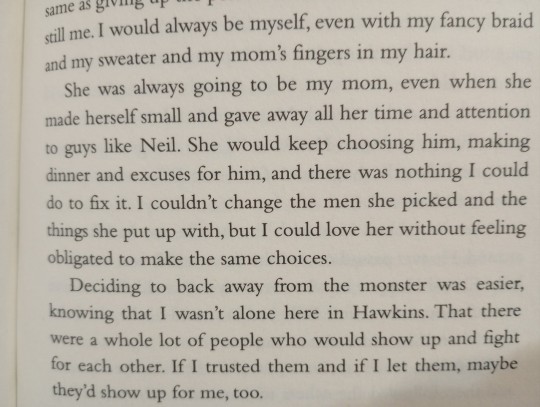
And come season 4, they show up for her: The moment everyone realized Max was next on Vecna's kill list is the moment they sprang into action to protect her to the best of their ability while attempting to take Vecna down.
There was an interview where the Duffer Brothers admitted they originally planned to kill off Max at the end of season 4 before changing their minds. I know there are people in this fandom who complain about certain characters having plot-armor (and I could do an entire separate post about how that term gets thrown around willy-nilly these days), but in Max's case, I'm glad they didn't go through with it. For a character who's an abuse survivor and has endured repeated trauma in the hopes that thing would eventually get better, killing Max off like that would have been a mean-spirited way to end her story. It also would have made her entire arc pointless and nihilistic. At least here, there's the possibility of Max returning from the brink.
In both my reviews of The Other Side and Erica The Great, I've talked about how it's likely Max's consciousness has been assimilated into Vecna following the battle at the Creel House, which is why her mind is blank when El tries to communicate with her at the end of season 4. Based on that, Max's arc may be about maintaining her individuality from within Vecna as a means of continuing to resist him, and eventually finding a way to break free from his control and regain her sense of self. Thematically, it would also serve as a satisfying conclusion where she's no longer defined by her trauma or the monsters in her life who have repeatedly dragged her down (Billy, Neil, Vecna). She can finally have an identity and life outside of that.
Of course, there's also the fact that even if her consciousness escapes Vecna's control, she'll still be returning to a broken body, with the very real possibility of being blind and crippled for the rest of her life. I'd actually be interested in seeing that as opposed to the Duffer Brothers coming up with some Deus Ex Machina to magically fix Max's body and make her whole again. Scars and injuries of that extent don't fully heal in real life, and even though Stranger Things isn't a show grounded in reality, it would be nice if they could show a character that's become disabled who's still able to find a way to adjust to her situation, live fully, and gain some semblance of peace within herself.
Part 2: Max And Her Friends
Part of the brilliance of the book is we get a lot more insight into Max's thought regarding certain characters and what she thinks of them, which helps shed more light on how she relates to them on the show.
Take her relationship with Mike for instance: She is (rightfully) not impressed by how he keeps trying to exclude her from the group and shows her nothing but hostility. I know Mike's gotten flak for this from fans, and while his behavior isn't entirely excusable, there is at least context for how he acts here: To him, Max is a stranger who has no idea about El or the Upside Down, and he's not entirely sure he can trust her with that information. On top of that, he worries about Max becoming a replacement for El after her disappearance. It's not a rational way to think, but there is an emotional component to this that Max understands:
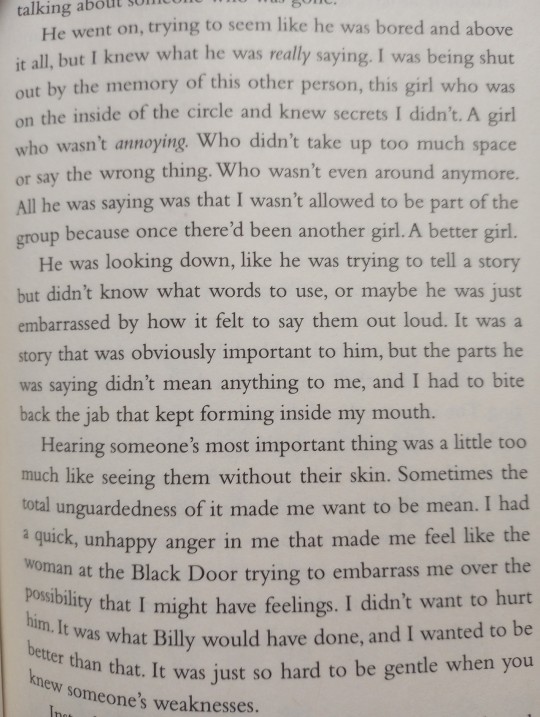
Couple of things to note here:
1.) Max is consciously making a choice to be better than Billy. She sees Mike in a rare moment of vulnerability, and even though it would be easy for her to be snide and mean towards him, she instead chooses to be empathetic. That may not seem like a big deal, but I can say from personal experience that I've encountered people (both online and off it) who act like sharks the moment they smell blood in the water. Show any kind of vulnerability or weakness, and they become the most condescending, belittling, self-righteous person you can imagine. For whatever reason, they get some kind of smug superiority in tearing others down to elevate themselves. I've been on the receiving end of that one too many times, and I have nothing but contempt for people who act like that. They are devoid of empathy, and are unkind to others when it is convenient for them. I will always have more respect for those who show compassion towards the vulnerable over those who tear them down.
2.) For as much as Mike and Max are at odds with one another on the show, they have many similarities: They're both headstrong, with a take-charge attitude. They both have issues conveying their emotions in a way that doesn't make them appear moody or hostile to others. And they both care deeply for those they love.
For as much as Max acts emotionally distant on the surface, she wants to have friends and belong somewhere. She wants to be Mike's friend despite how he initially treats her. It's why she continues reaching out to Mike, and even suggests becoming the Zoomer of their Party while roller-skating around him to make him laugh.
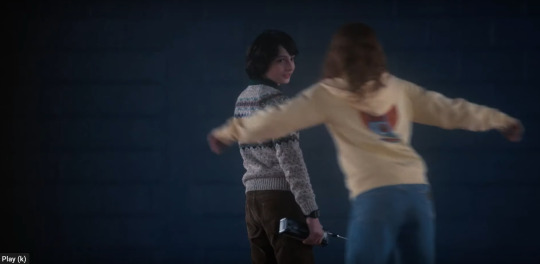

It's also why she jumps at the opportunity to get to know El better in season 3 when she takes her shopping and introduces her to other aspects she hasn't experienced yet, like the mall and Wonder Woman comics and sleepovers and so on.
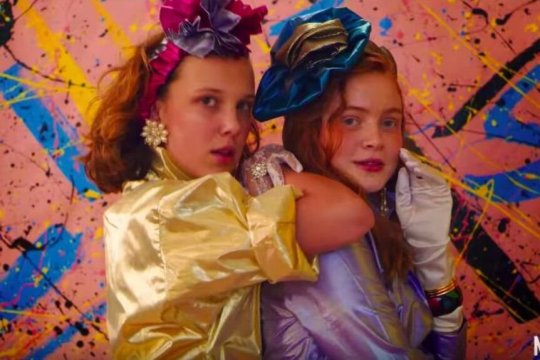
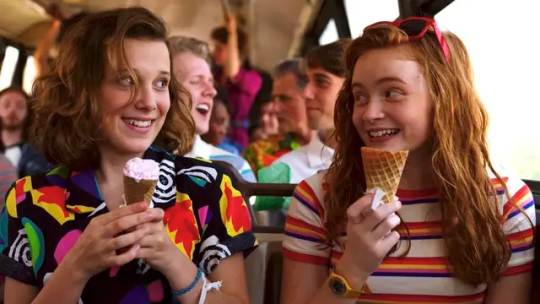
Side Note: In recent years, I've gained a new appreciation for the El/Max scenes in season 3, especially with how important they were in briefly helping Max break free of Vecna in season 4. It's also the first time Max has ever had a friend who's a girl, and she intended to make the most of that during her time with El.
We don't really get much interactions between Will and Max in the book, but I love how she called out the stupidity of Will's nickname "Zombie Boy," and notes that someone who allegedly came back from the dead is not the kind of person you'd want to bully:
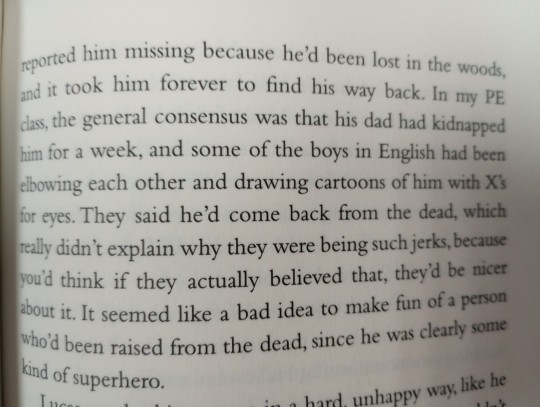
She also notes the difference between Lucas and Dustin in how they talk to her, which gives more context for why she ultimately ends up with Lucas by the end of the book:
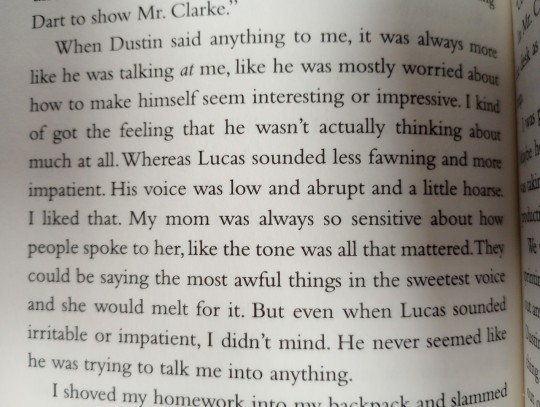
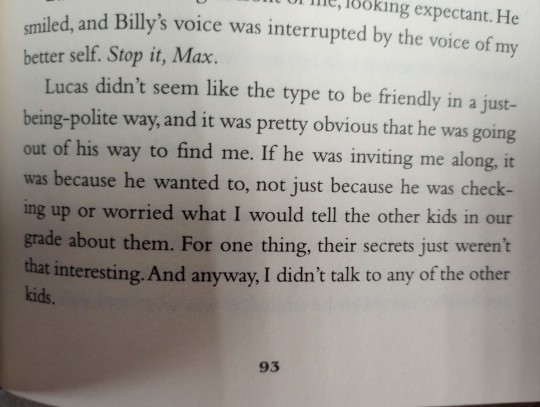
I like Dustin, but I'm in the crowd that believes Lucas and Max make a better couple, and that Dustin and Max work better as friends. Lucas is the one who listens to her and allows her to be vulnerable in a way where she feels safe and not judged.

He's also the person who (aside from Steve) Max felt protected by. She can be around Lucas without worrying about whether or not he'll abandon her:

Speaking of Steve, I know it's a common perception in the fandom that he's the "big brother figure" Max wishes Billy had been, and this book leans heavily on that interpretation. Unlike other adults, Steve isn't condescending to Max, goes out of his way to treat her as one of the group despite only knowing her for a few hours, and later protects her from the demodogs when she's in danger:
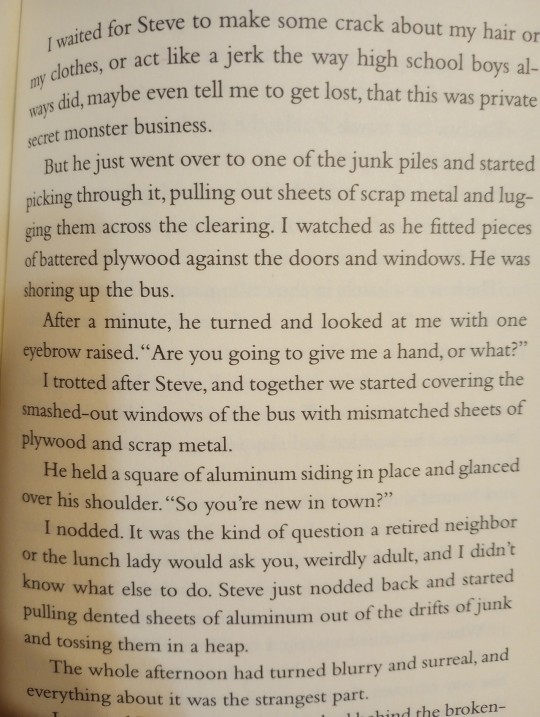

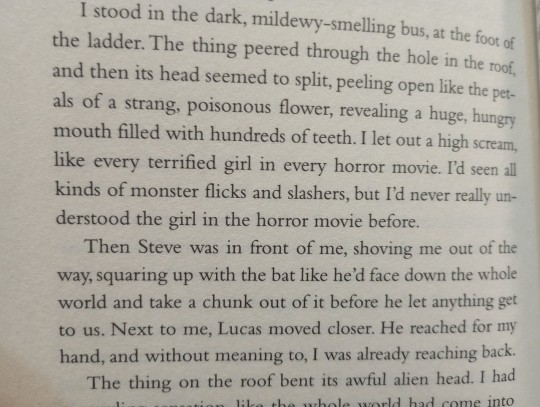
That's probably the first time someone's really stepped up for her like that, and she repays him later by saving Steve from Billy.
Finally, there's this little bit regarding Max's thoughts about Nancy:
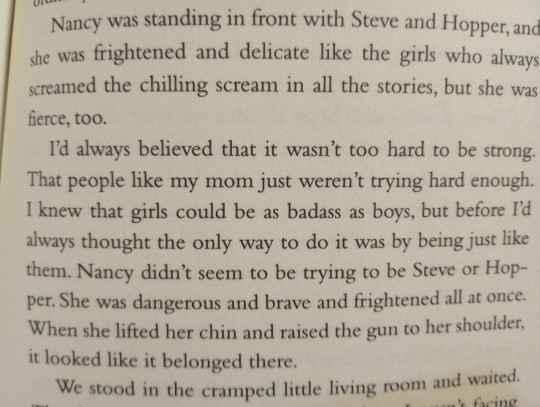
It's refreshing to see the breaking down of stereotypes here, and the idea that women have to channel male qualities in order to be "badass" or taken seriously. Nancy is able to be her own person, in her fear, bravery, and determination, without having to emulate Hopper or Steve or any of the other male characters in the room, and Max realizes she can be as well. I would even argue Max channels Nancy when she's later holding Steve's spiked bat over Billy:

She managed to emulate both Steve in his protectiveness towards others, and Nancy in her fierceness, and it's an empowering moment for her.
To be continued in Part 2.........
#stranger things#max mayfield#stranger things runaway max#lucas sinclair#lumax#anti billy hargrove#neil hargrove#mike wheeler#will byers#el hopper#dustin henderson#joyce byers#steve harrington#nancy wheeler#tgh opinions#tgh reviews#the duffer brothers
26 notes
·
View notes
Note
Sense you mentioned it, what's the name and general plot of the DND campaign you were worried would go on infant hiatus? Only if it's a public/streamed/recorded campaign.
-An Observatory 🌙
Well, then. I’ve been waiting for someone to ask this.
The campaign was a sort of slightly (emphasis on slightly) comedic, yet still very much horror-focused, version of the infamous Curse of Strahd.
The channel, if you’re interested, is called SpiffyNeedleGeeks. They’re a very small channel, being most famous for Smash trailer reactions back when Ultimate was just coming out a few years ago. Besides the DND, it’s mostly big AAA games they do, but they also cover horror every now and again each October!
Only about, like, 5% of their 2.5k subscribers pay any attention to their DND stuff. Besides that, they’re running two other (not cancelled) campaigns: Ravnica: Trail of Dragons (which I will admit I haven’t watched), and Strixhaven: A Curriculum of Chaos (which I have watched).
Anyways, back to Curse of Strahd… I’m pretty sure everyone knows how that campaign goes, but this one has a lot of unique twists and turns to add a sense of spice to it. If I were to sum it up in a very out-of-context way:
Basically, a dragon-worshipping Disney princess, a magical macaroni velociraptor soldier, Interdimensional Shitlord Pinocchio, a green Simon Belmont ripoff, a sword-wielding shiny Charizard with a fairy waifu, Big Bird, and the least scary demon you will ever meet try to fight a vampire and then get deeply traumatised.
Go… check it out, if you’d like! They’re not technically listed as podcasts on YouTube, but it still makes for a pretty fun thing to listen to as, like, background noise!
BUT: I will warn you first, try to avoid looking at the thumbnails of any future sessions at ALL COSTS. The thumbnail art updates as the PC’s designs change in-universe, and thumbnail art updates tend to happen pretty commonly over the course of the campaign. Each contains MASSIVE spoilers, so try and avoid them by any means necessary, as difficult as it may be.
And, if you see a playlist marked “SNG Streams: Dungeons and Dragons”, don’t open that either. That playlist is meant to hold oneshots and silly character creation streams, but for some reason a good 2/3rds of it is filled with Curse of Strahd sessions. JUST CoS, for some reason. And it begins with Session 20, a long way into the 30-session campaign. So don’t click it. Just click Curse of Strahd, and don’t scroll too far.
Anyways, if you do intent on listening to Curse of Strahd- or, heck, any of their campaigns- try and update me! I have been stuck waiting to be able to talk to someone about this after two and a half years of it being a hyperfixation of mine, so I’m… kinda going bonkers at this opportunity?
Anyway, have fun, Observatory! And whoever else is reading this, you can all check this out if you like!
3 notes
·
View notes